Introduction to Tourmaline Group Minerals
Minerals of the tourmaline supergroup occur in a wide range of colors and form spectacular crystals, which makes them highly popular among mineral collectors. Tourmaline is also important geochemical and petrological indicator.
Tourmalines are complex borosilicate minerals, organized into a tourmaline group. They share the same structure with highly variable chemical composition.
Tourmaline Group Minerals
There are currently 43 IMA approved minerals in the tourmaline group. New exotic tourmalines are identified almost every year, often because of the better analytical methods available. However, most of the exotic species are known only in small pieces from a few localities worldwide – some even from a single occurrence.
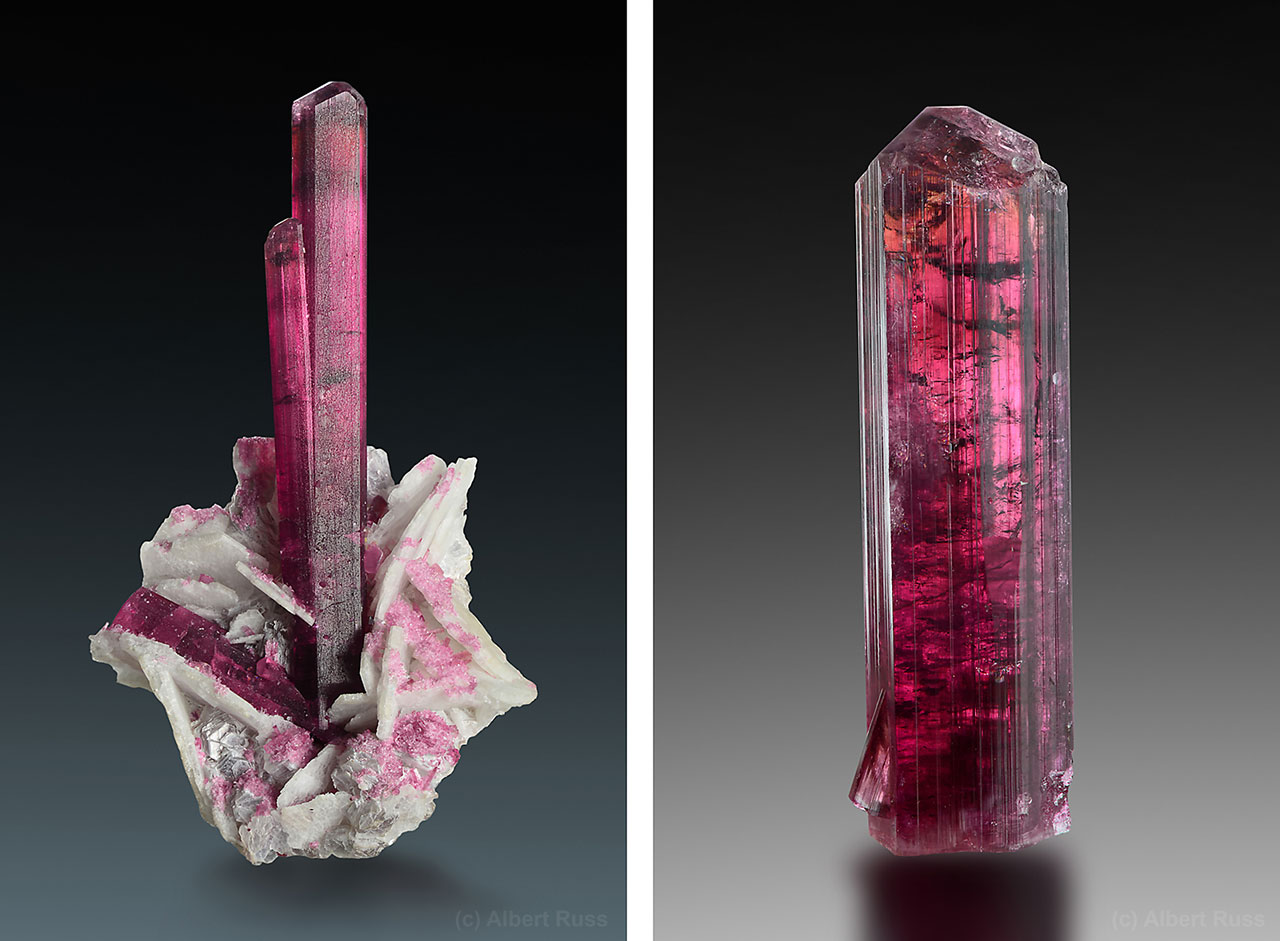
The beginning of the tourmaline group was established in early 1920s, when the newly available X-ray diffraction confirmed relationship of the 3 known tourmalines - schorl, dravite and elbaite. It rose to 6 known tourmalines in 1950s, 14 tourmalines in 1999, 27 tourmalines in 2009 and, finally, 43 tourmalines in 2023.
Some of the estimations state that up to 98% of all tourmalines are only 3 members - schorl, dravite and elbaite. This is not exactly true, because there are also fluor- and hydroxy- variants, which are different minerals. Especially significant part of the elbaite is in fact fluor-elbaite. But it gives some scale how rare most of the exotic tourmalines is.
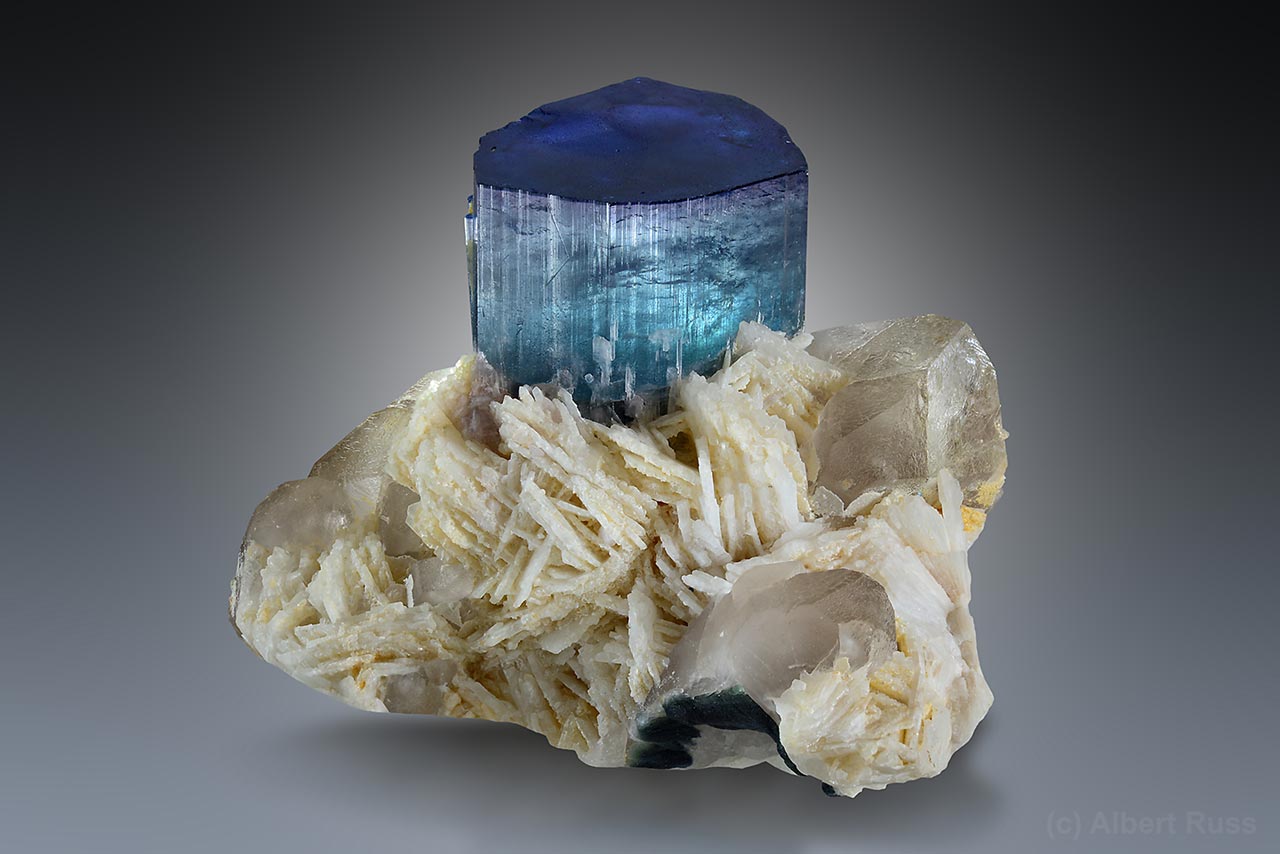
Disclaimer: For the sake of readability of this article, the term „schorl“ refers to schorl and fluor-schorl without explicitly naming them both. The same applies to most other tourmalines, so “elbaite” refers to elbaite and fluor-elbaite etc. It does not include oxy- variants, because these require more complex substitutions.
Crystal Structure and Chemical Composition of Tourmaline
All tourmaline group minerals have a single generic chemical formula:
XY3Z6(T6O18)(BO3)3V3W
The structural positions - especially XYZ - may be occupied by very wide range of elements:
| Structural position | Elements |
|---|---|
| X | Na+, Ca2+, K+, |
| Y | Li+, Mg2+, Mn2+/3+, Fe2+/3+, Al3+, Zn2+, Ni2+, Cu2+, Cr3+, V3+ |
| Z | Al3+, Mg2+, Fe2+/3+, Cr3+, V3+ |
| T | Si4+, Al3+ |
| B | B3+ |
| V | O2-- |
| W | OH-, F-, O2-- |
Tourmalines belong to cyclosilicates, with basic six-membered ring made of SiO4 tetrahedrons. The hexagonal symmetry is decreased by 3 distorted triangular BO3 units and cation positions distributed between the stacks and inside the channels. Currently, all the IMA approved tourmalines are trigonal. Luinaite-OH was considered monoclinic tourmaline, but it was discredited in 2022. There are some yet unnamed tourmalines which seem to be triclinic.
Tourmalines seldom form perfect euhedral crystals, but rather elongated three-sided prisms, usually with slightly curved faces. However, the prisms are often more complicated and/or form hypoparallel growths. Terminations on both ends are often different, which is called hemimorphism.
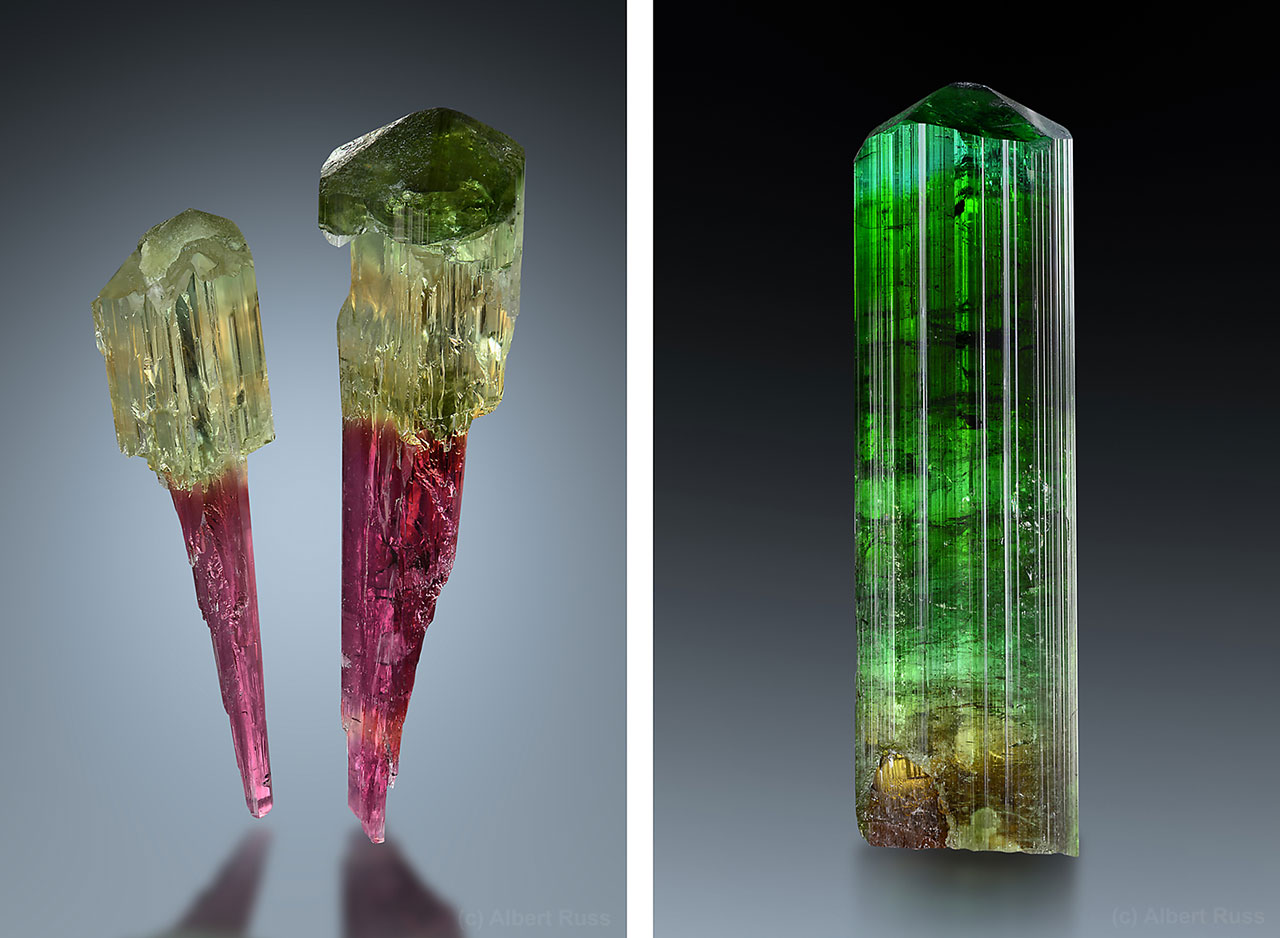
Tourmaline is often called a trashcan, because it can accommodate many various cations. The tourmaline composition is rarely close to the pure endmember, but rather has significant content of other components. E.g., common schorl often contains significant amount of Mg (dravite component), some F (fluor-schorl component), it can contain more Al and Li (elbaite component).
Another unfortunate property of tourmaline structure is the common structural disorder. Some elements can enter multiple positions and they often occupy more than one. Typically, Mg2+ or Fe2+ may enter both Y and Z positions and are often spread in both.
Physical Properties of Tourmaline
Despite having highly variable chemical composition, all tourmaline group minerals have surprisingly similar physical properties: Tourmalines have light colored streak, vitreous to greasy luster and very poor cleavage on two planes. Of course, the color, refractive indices, cell dimensions and densities are highly dependent on the composition.
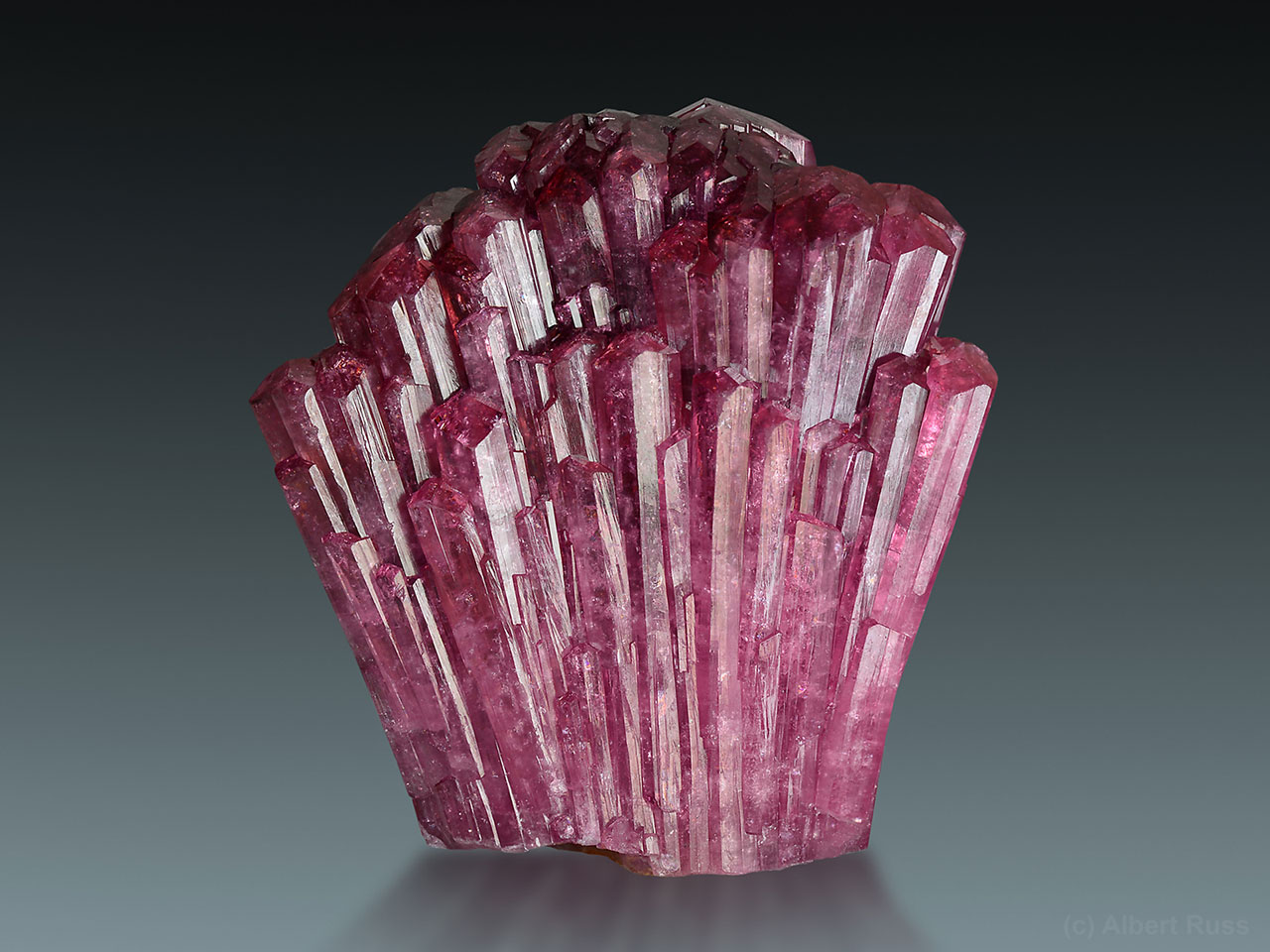
Tourmalines are quite hard with Mohs’ hardness ranging from 7 to 7.5, but they are brittle with conchoidal to uneven fracture. Tourmaline is strongly pleochroic with relatively high birefringence and weak dispersion. It is rarely fluorescent in UV.
Tourmalines have significant pyroelectrical and piezoelectrical properties. This means that they generate small electrical current when heated or pressed.
Tourmaline Color
Despite common myths, you cannot identify tourmaline by color! In the past, all black tourmalines were considered schorl and all brown were labelled as dravite. And all the colorful were considered varieties of the elbaite, which is unfortunately a way more complicated. The historically used elbaite varieties are:
| Elbaite varieties | |
|---|---|
| Rubellite | pale pink to red |
| Indicolite | pale to dark blue |
| Verdelite | olive green to vivid green |
| Achroite | colorless |
Unfortunately, there are numerous tourmalines sharing the same color. And there are also many tourmalines with various colors (elbaite, olenite, uvite), making their identification way more difficult.
There are some common ways like labeling all black tourmalines as schorl. In fact, even seemingly black tourmaline is not black. Thin slice would reveal the real color, which is often dark blue, dark green, dark brown or dark grey. Not only schorl, foitite, feruvite or lucchessite are black, also some iron-rich elbaite, fluor-elbaite or dravite might appear black. On the other hand, some schorls are dark brown, dark blue or dark green.
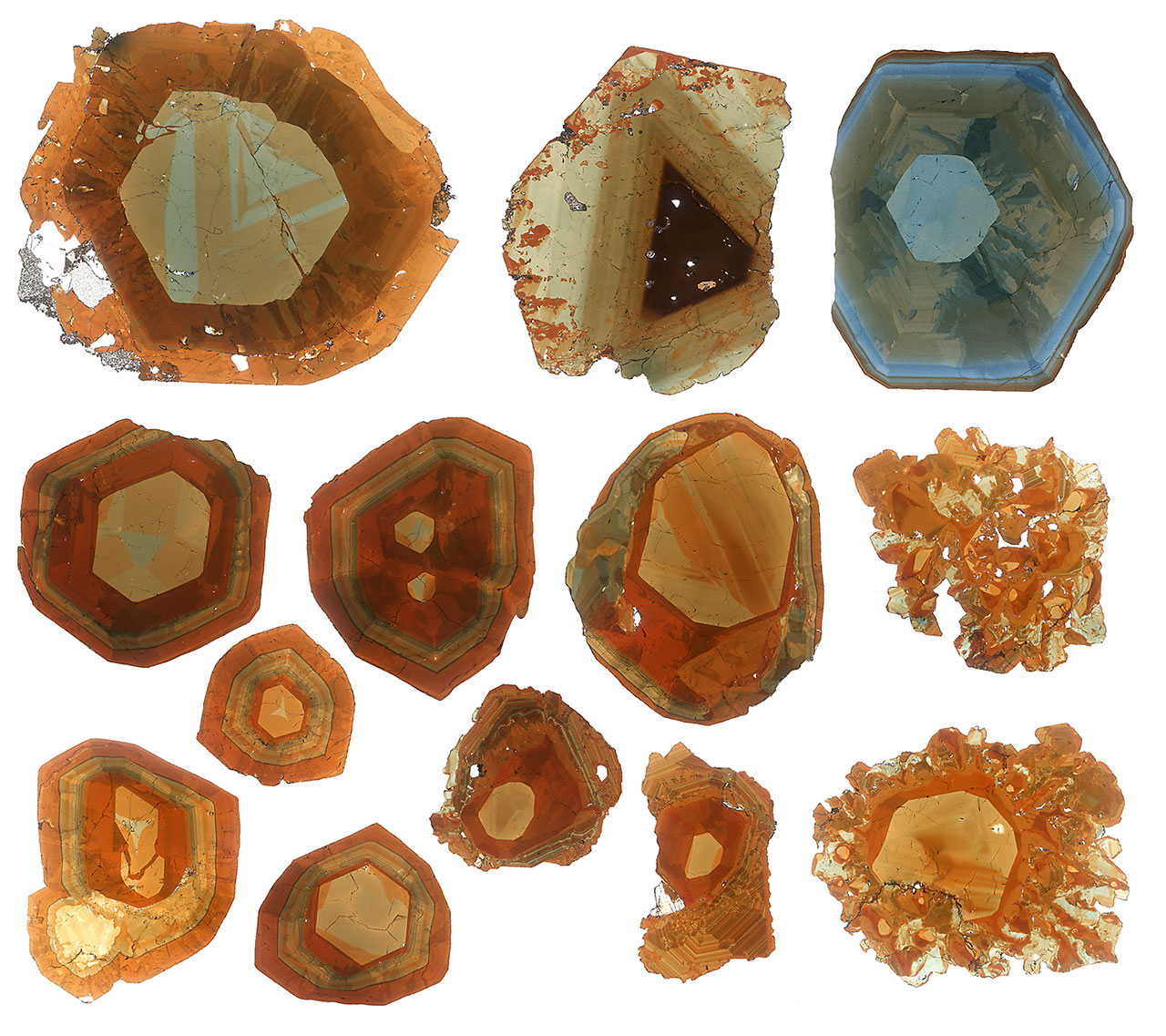
The most problematic color is perhaps the pink (rubellite), which could be elbaite, fluor-elbaite, rossmanite, liddicoatite, darrellhenryite, tsilaisite, olenite…
The most common chromophores are Fe2+, Fe3+, Ti4+, Mn2+ and Mn3+, less frequent are Cr3+, V3+, Cu2+ and some others. The final tourmaline color is affected by one or more chromophores and by intervalence charge transfer (IVCT). IVCT is a process in which incoming light causes an electron on the ion to be briefly transferred to another ion, typically Fe2+/Ti4+ or Fe2+/Fe3+.
The single chromophores turn colors to pink (Mn3+), yellow (Mn2+), bright green (V3+ or Cr3+) or pale blue (Fe2+). Particularly famous is the neon blue paraíba tourmaline, which is colored by Cu2+ in the Y position.
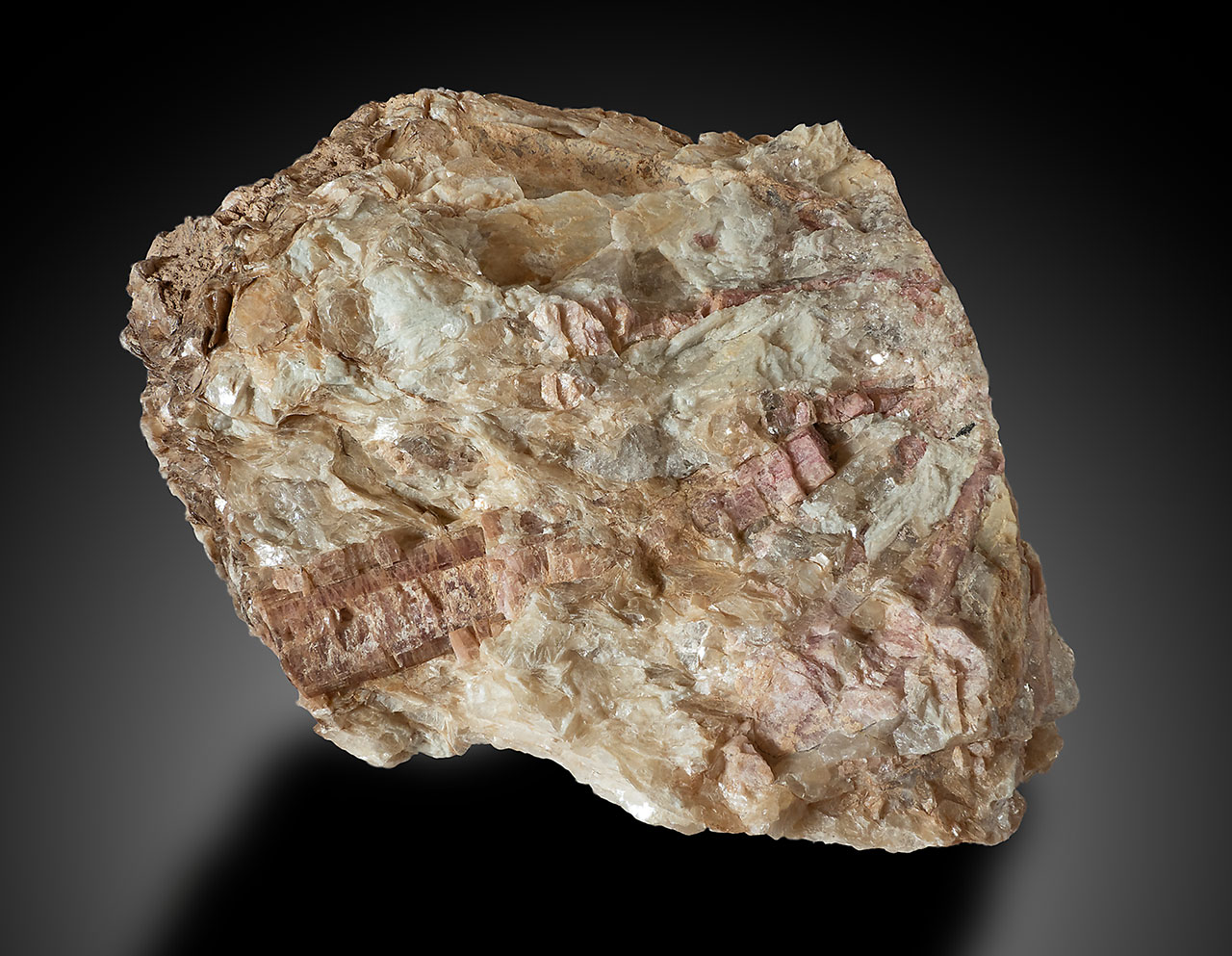
The color of the main chromophore may be distorted by other chromophores and/or IVCT. Typically, Fe2+ turns tourmaline color to pale blue, but presence of Ti4+ shifts the color to bright green or presence of Fe3+ makes the blue more saturated. Bright canary yellow tourmalines are result of Mn2+, but presence of Mn3+ or Ti4+ shifts color towards the brown hues.
The presence of Fe2+, Fe3+ and Ti4+ makes the tourmaline look black, despite its true color – very dark green, blue, or brown – is visible in think sections. On the other hand, the absence of chromophores makes the tourmaline colorless.
| Color | Tourmaline Species | Chromophore(s) |
|---|---|---|
| black | schorl, foitite, feruvite | Fe2+/Fe3+/Ti4+ |
| pink to red | elbaite, fluor-liddicoatite, rossmanite, darrellhenryite, olenite, tsilaisite | Mn3+ |
| yellow-brown, red-brown, brown | dravite, fluor-buergerite, uvite | Fe3+ |
| pale yellow | elbaite, fluor-liddicoatite | Mn2+ and Ti4+ (IVCT) |
| saturated yellow | elbaite, fluor-liddicoatite | Mn2+ |
| pale blue | elbaite | Fe2+ |
| saturated blue | elbaite | Fe2+ and Ti4+ (IVCT) |
| neon blue | paraíba tourmaline (elbaite) | Cu2+ |
| pale to dark green | elbaite, olenite | Fe2+ and Ti4+ (IVCT) |
| bright green | dravite, uvite | Cr3+ or V3+ |
| colorless | elbaite, fluor-liddicoatite, olenite, rossmanite, darrellhenryite | None |
Origin
Perhaps the most critical component for the tourmaline formation is boron. Boron is not abundant and its highly volatile, so it basically concentrates in highly fractionated rocks. These are usually late granitic melts, the very last part of the granitic magma, highly enriched in elements like F, P, B, Li and usually with very high Na and Al. And importantly, they have quite high water content. There are basically two kinds of these rocks: pegmatites and greisens.
Pegmatites are considered magmatic vein rocks, but their origin and classification are quite complex. Most common are granitic pegmatites, which have composition very similar to granite, and usually form dikes or lens shaped bodies. Pegmatite melt can be derived from granitic intrusions, or it can be result of partial melting during metamorphic events (so called anatectic pegmatites).
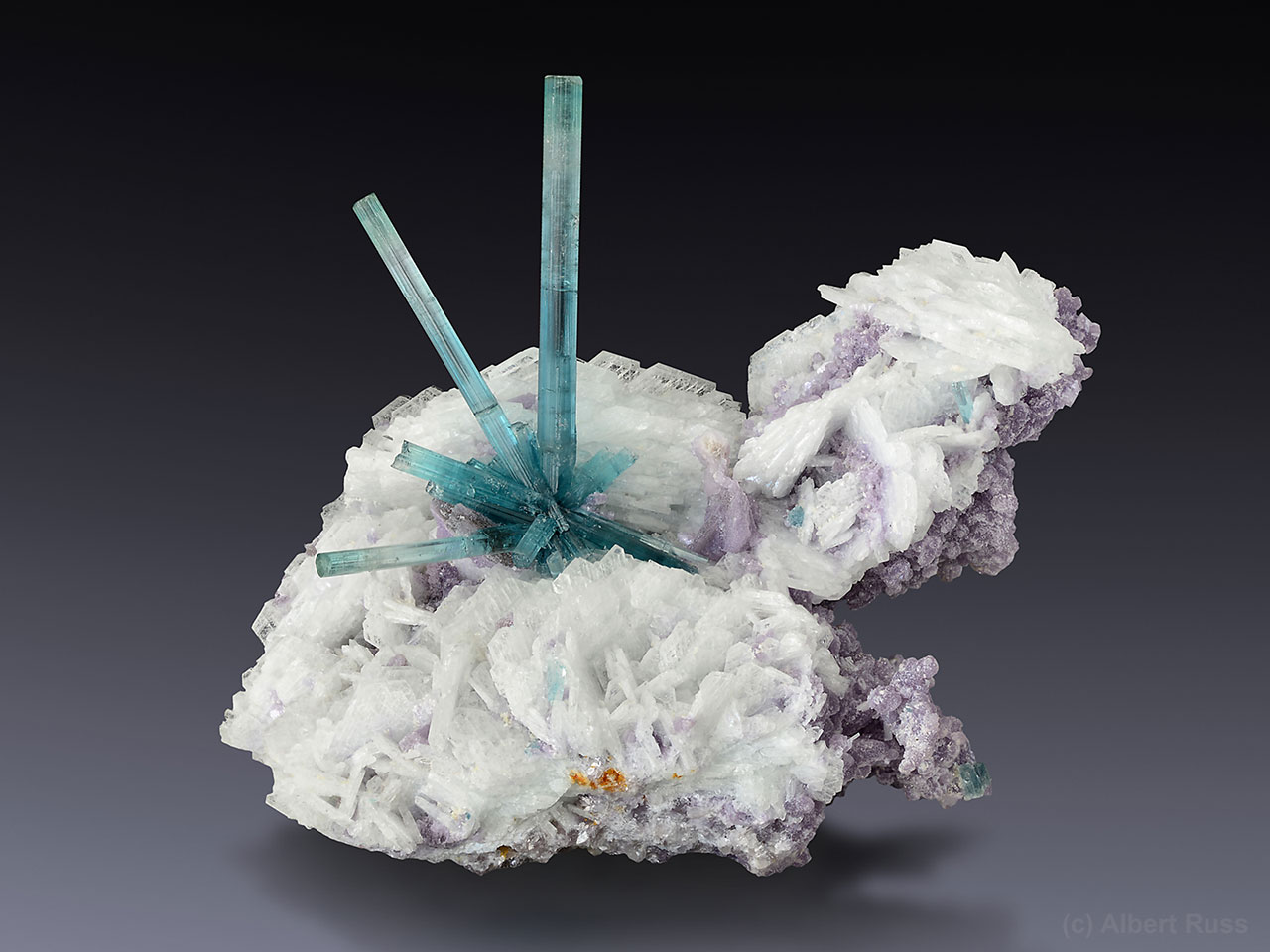
Regardless of their origin, many pegmatites are highly enriched in volatile elements, often including significant amount of boron. This leads to formation of various tourmalines: The most primitive pegmatites or outer units of evolved ones usually contain dravite, schorl and foitite, while inner units of highly evolved lithium pegmatites (called LCT-pegmatites) often contain colorful lithium tourmalines like fluor-elbaite and liddicoatite. Most of the exotic tourmalines was identified in pegmatites.
Greisens are another complex and problematic rocks. They are considered magmatic or metasomatic by various researchers. Greisens do not have a simple definition, generally, they form as the very last stage of crystallization of granitic intrusion. They form from last remnants of still liquid granitic melt or even just supercritical fluids (thus considered metasomatic) with extremely high content of volatile elements. Unlike pegmatites, they are often highly enriched also in Sn, W, Mo and As, and can contain significant amount of other metals and sulfur. Greisens usually contain only schorl.
Of course, tourmalines (mostly schorl or fluor-schorl) are present in many fractionated granitoids as accessory minerals. They can form crystals, orbicular formations or be present as late fracture fillings. The black tourmalines sometimes form tourmalinite rock.
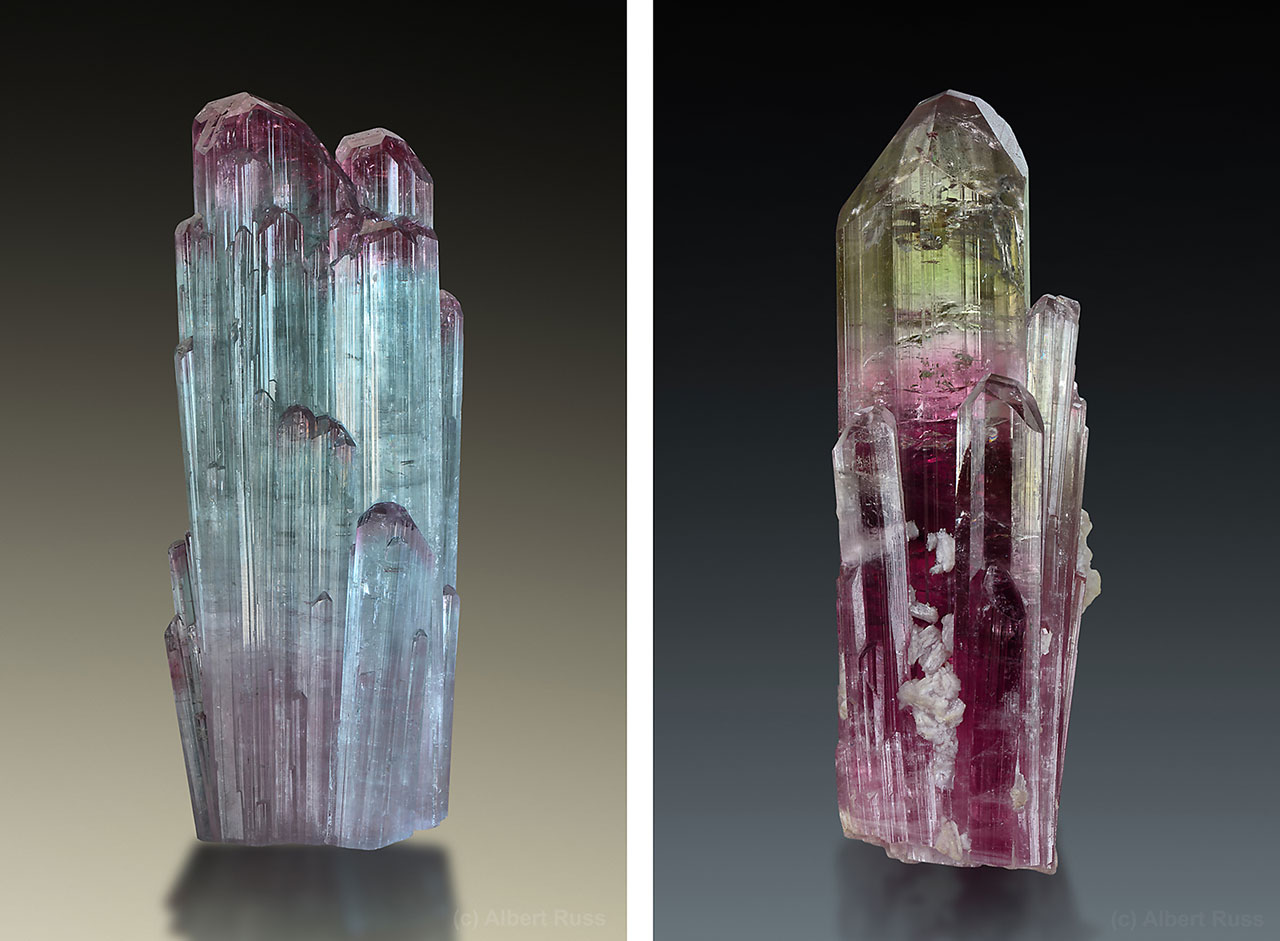
Another potentially tourmaline rich rocks are certain metamorphic rocks formed from another boron-rich rocks: hornfels, some special skarns, amphibolites and marbles. Some meta-ultrabasic rocks and exotic quartzites and exotic schists may contain rare V and Cr rich tourmalines.
Tourmaline is highly resistant to both physical and chemical weathering, and its density is slightly above average. Thus, it can also concentrate in some clastic sediments like sandstones and wackes.
Tourmaline Uses
Probably the most widespread tourmaline use is in the jewelry as gems. The durability, huge variety of colors and reasonable price make tourmaline a very popular gemstone. The tourmaline was used as a gemstone since about 2000 B.C. in ancient Egypt and its pyroelectrical properties were discovered already in the ancient Greece. First colorful tourmaline gems were brought to Europe from Sri Lanka (formerly Ceylon) by the Dutch East India Company in late 1600s.
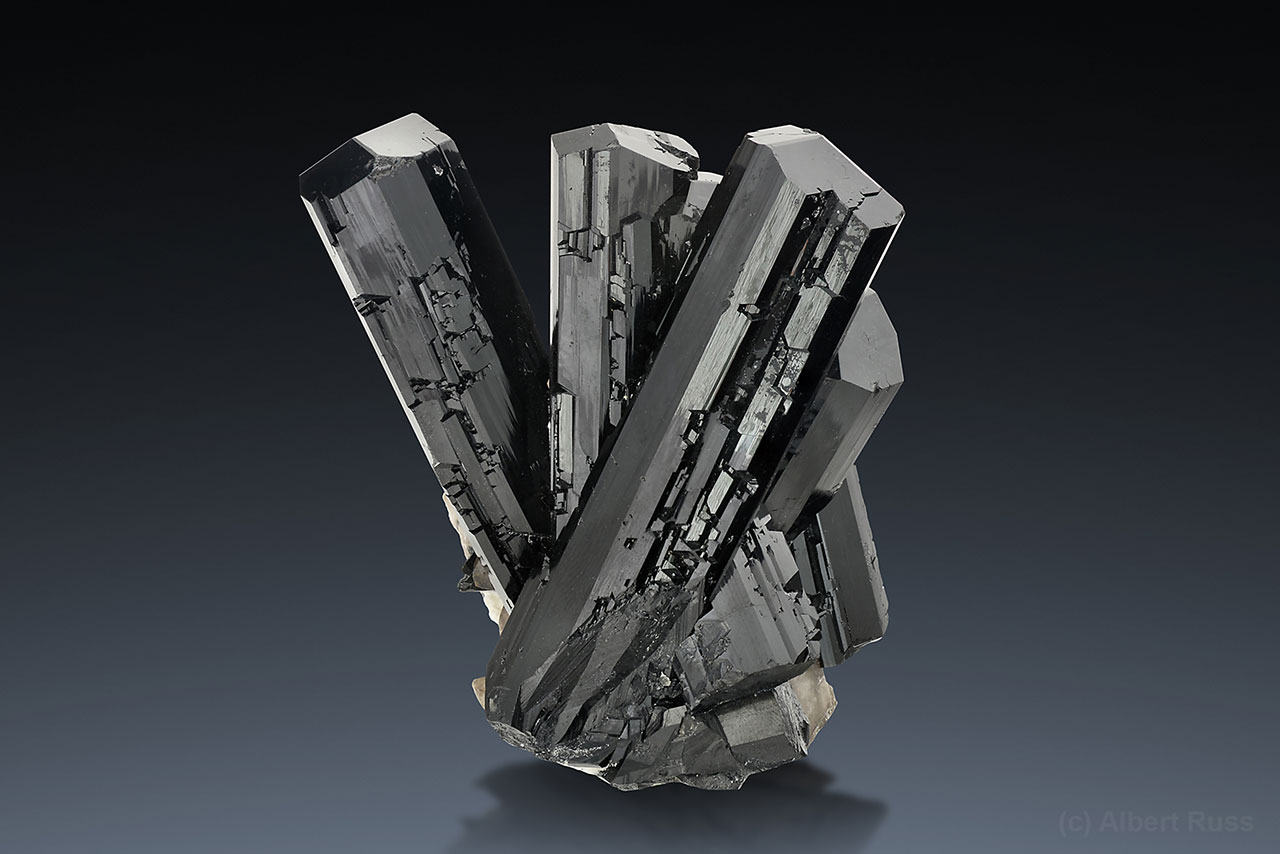
One of the funny tourmalines uses was as a remover of ash from the pipes. The heated tourmaline crystal attracts tiny particles because of its pyroelectrical properties - including the ash. The Dutch merchants called the tourmaline crystals ashentrekker, which means ash drawer.
The piezoelectrical properties were practically used since early 1900s in pressure sensors and became a standard for most electrical pressure gauges in next decades. The technological boom after WWII resulted in tourmaline applications in microphones, oscillators, amplifiers and many other devices. This bloom was ended by the successful production of cheap synthetic piezoceramic materials, which lack natural defects and irregular composition.
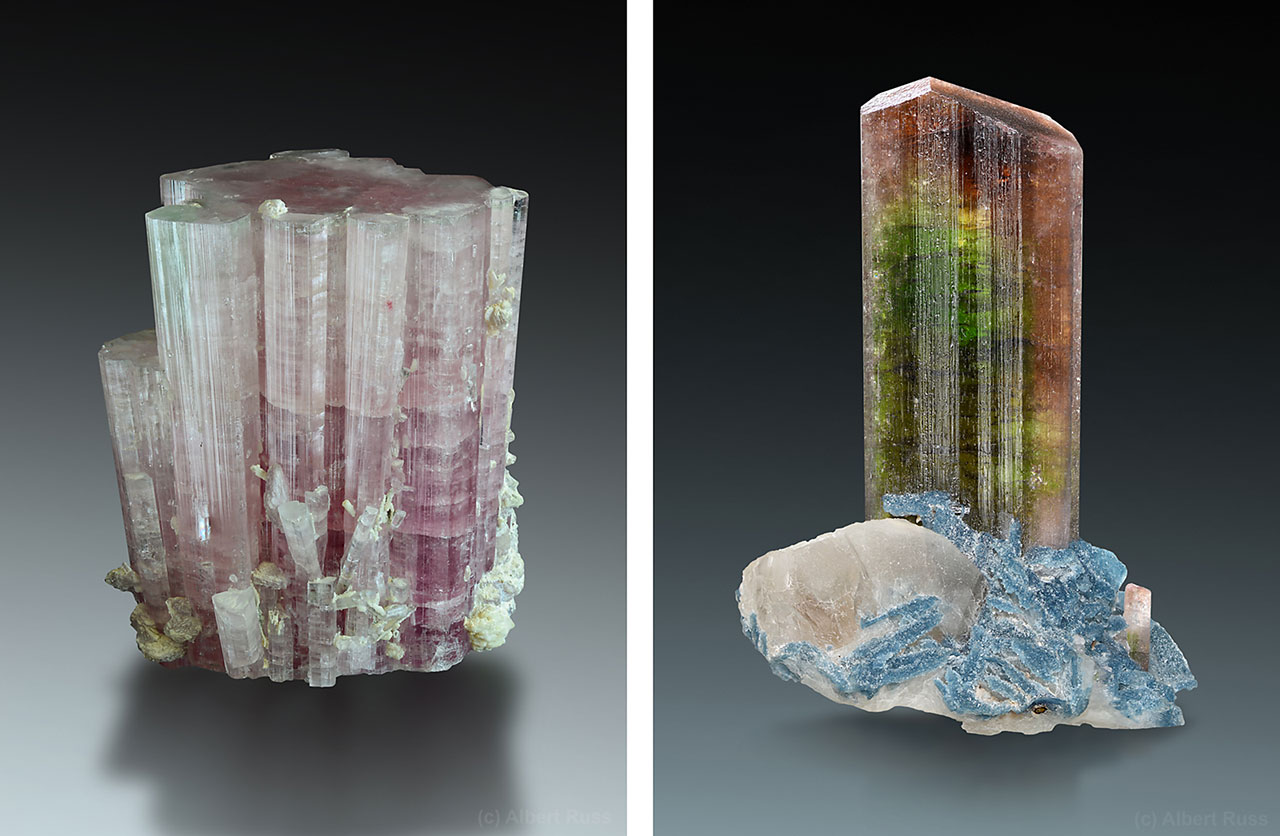
Well-formed aesthetic and colorful crystals of tourmalines belong to highly prized specimens among mineral collectors. The prices are so high that some mines turn profit solely from mining collectible specimens. Material unsuitable for mineral collectors can be processes into faceted gems or cabochons.
Classification and Identification Problems of Tourmalines
The tourmaline group has already dozens of members, with constant discovery of new exotic species. Their chemical complexity itself creates lot of problems for proper identification. The structural disorder and ability to incorporate lot of impurities within their structure makes it even worse.
Another big issue is the zoned composition of many crystals, when chemical composition slowly or abruptly changes within a single crystal. Typical example is watermelon tourmaline, where pink interior is more Mn and Li enriched and outer green zone contains more Fe. However, much less apparent chemical variability is common in many tourmalines. One single tourmaline crystal from LCT (lithium rich) pegmatite might contain 3-5 valid IMA minerals! How do you analyze (and label) such specimen?
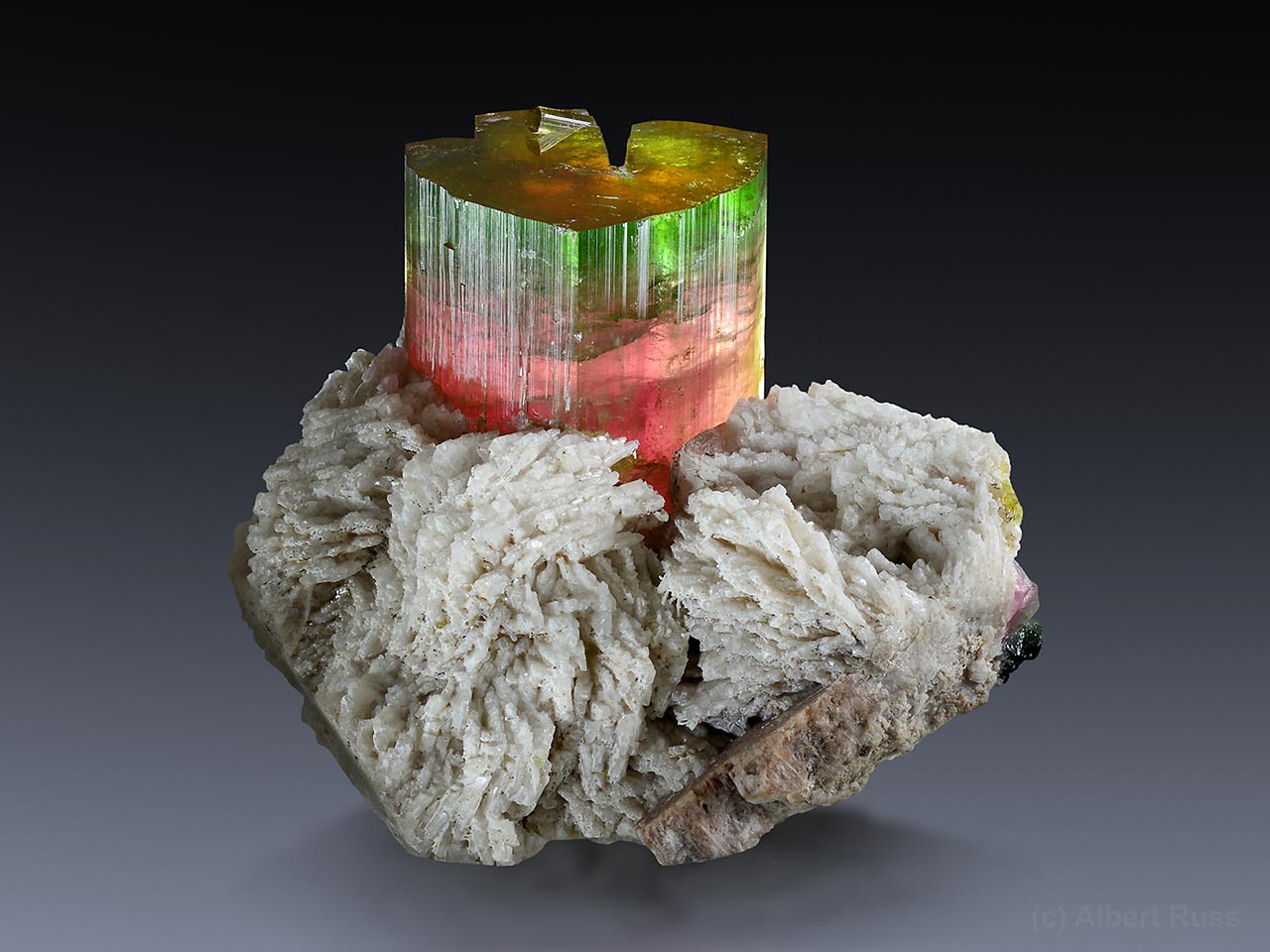
Classic methods fail or provide inaccurate results: Most electron microprobes (EMPA) cannot analyze B, Li, OH and vacant positions. And EMPA cannot distinguish Fe2+/Fe3+ or Mn2+/Mn3+. There are quite precise empirical methods to calculate missing data, but it inevitably leads to errors in the final calculated formula.
The X-ray diffraction has problem with tourmaline solid solutions and structural disorder, which produce huge overlap of diffraction lines (d-values). Thus, this method rarely leads to precise identification.
Full and precise analyze of tourmaline specimen is very expensive and complicated. Mostly EMPA is used to get main elements, then LA-ICP-MS is needed to measure B, Li and OH content. Mössbauer spectroscopy is used to analyze Fe2+ and Fe3+. If exact structure is needed, then single crystal X-ray diffraction is used.
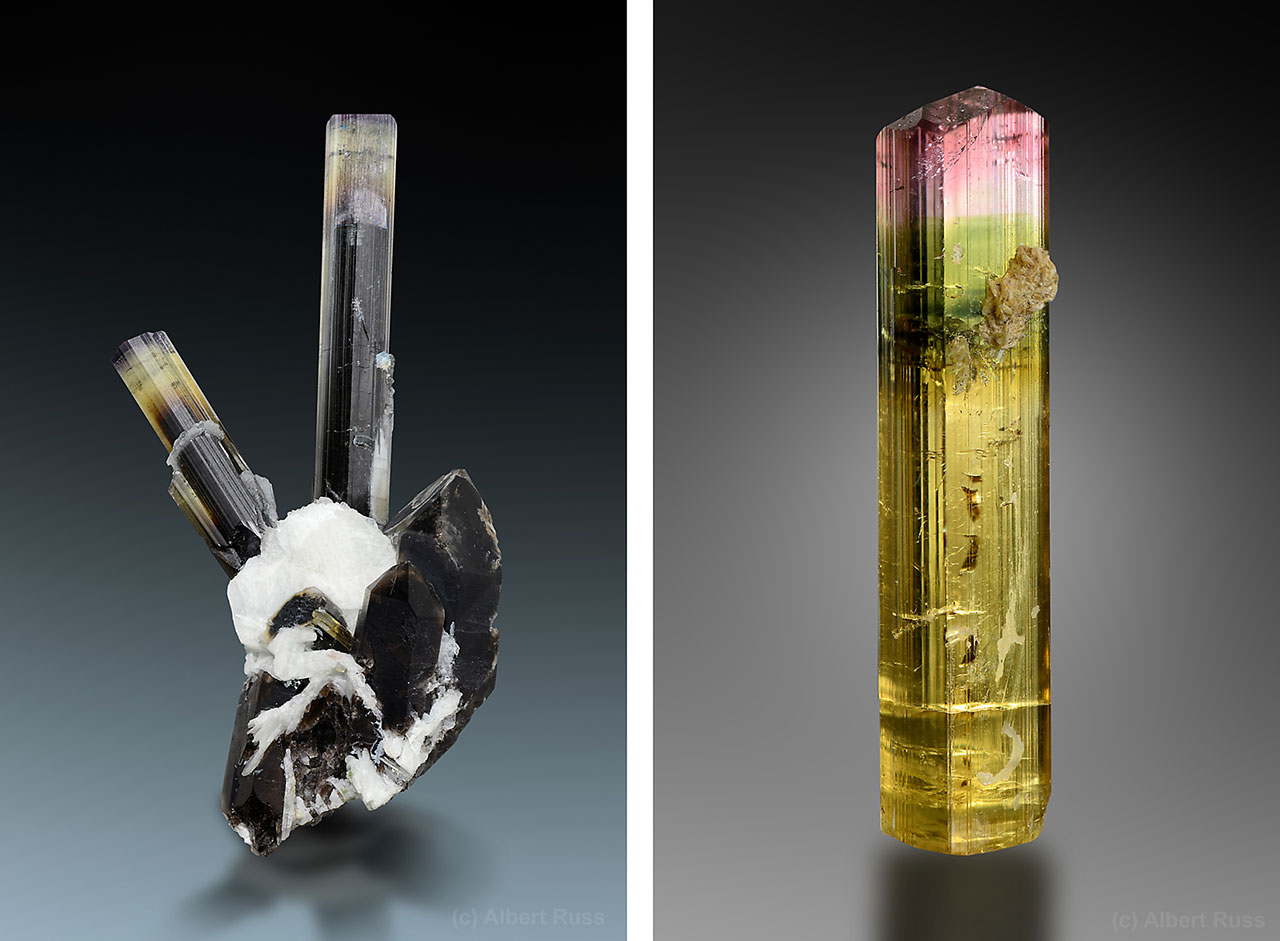
These analytical problems lead to many changes in the tourmaline nomenclature. E.g., liddicoatite holotype is F-dominant, yet it was approved with OH-dominant formula. Thus, the mineral was later renamed to fluor-liddicoatite. Uvite and tsilaisite were fist approved, then discredited years later, and then approved again from different type localities.
Tourmaline Solid Solutions
Many tourmalines form complete solid solutions and basically all have at least partial miscibility. There are certain combinations of elements, which are unlikely and/or cause structural problems. Typically, Mg- or Cr-rich tourmalines do not occur within internal units of lithium (LCT) pegmatites.
The miscibility of various tourmalines is caused by substitutions. Unlike more simple minerals, real tourmaline formula is far from ideal endmember and might get really complicated with decimal indices.
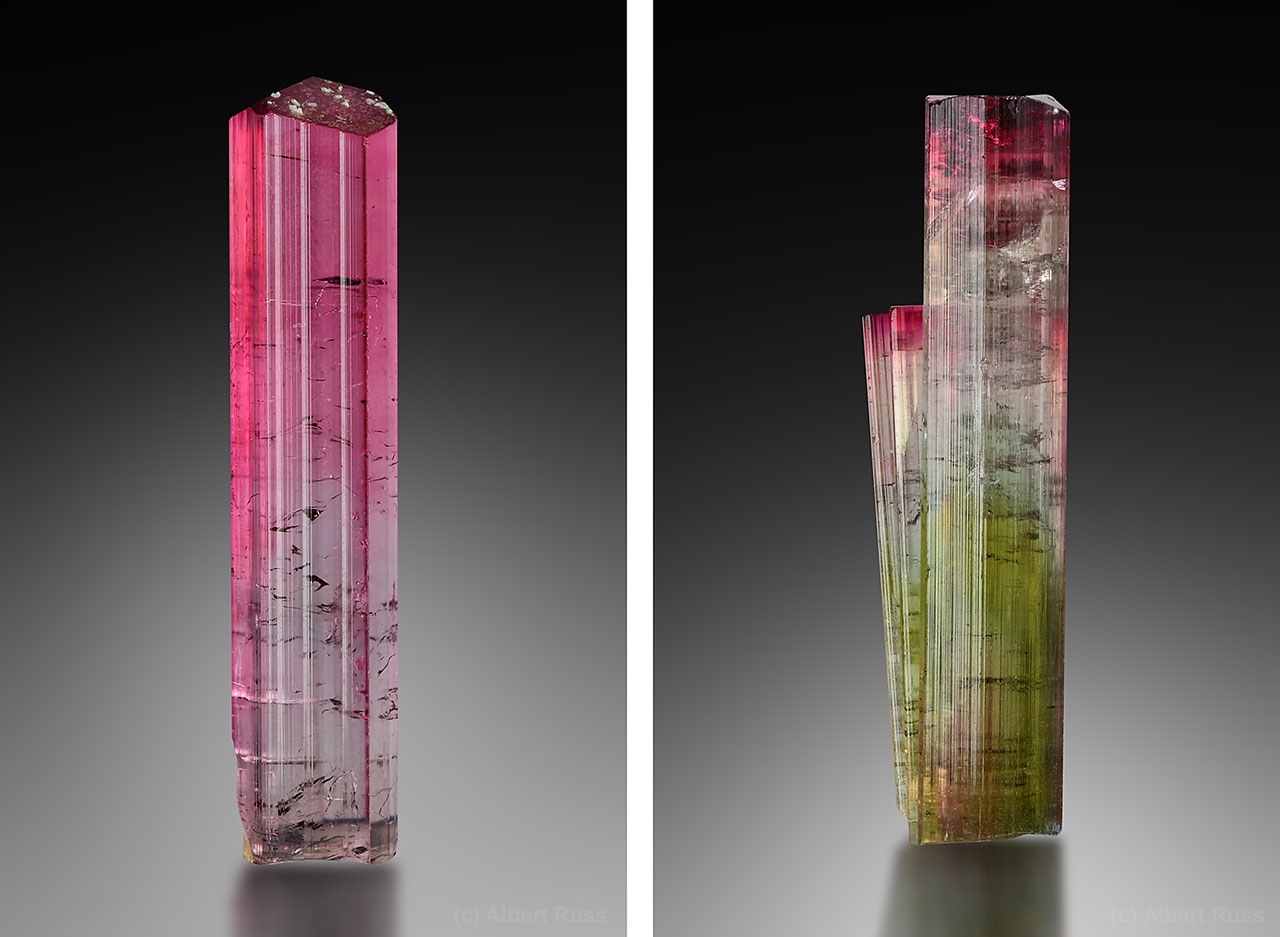
Right: Zoned green tourmaline crystal with red termination from Cruzeiro mine, São José da Safira, Minas Gerais, Brazil. Size: 4.6 x 1.3 cm. Ex. Anton Watzl collection, Albert Russ photo.
When only one cation is partially or fully replaced by another cation of the same charge, its called homovalent substitution. Common example might be dravite-schorl series, where Mg2+ is replaced by Fe2+. Or very common replacement of hydroxyl (OH)- anion in tourmaline W position by fluorine F-. The latter is the mechanism behind schorl/fluor-schorl or uvite/fluor-uvite origin.
However, way more common are heterovalent substitutions, when one or more ions are replaced by another ions. Typically, when Li+ replaces some Fe2+ in Y position, the charge difference must be balanced by something else. This substitution might work just in Y position like schorl-elbaite substitution:
3 YFe2+ <=> 1.5 YLi+ + 1.5YAl3+
or it can get more complicated in two structural positons like schorl to oxy-schorl substitution:
YFe2+ + W(OH)- <=> YAl3+ + WO2-
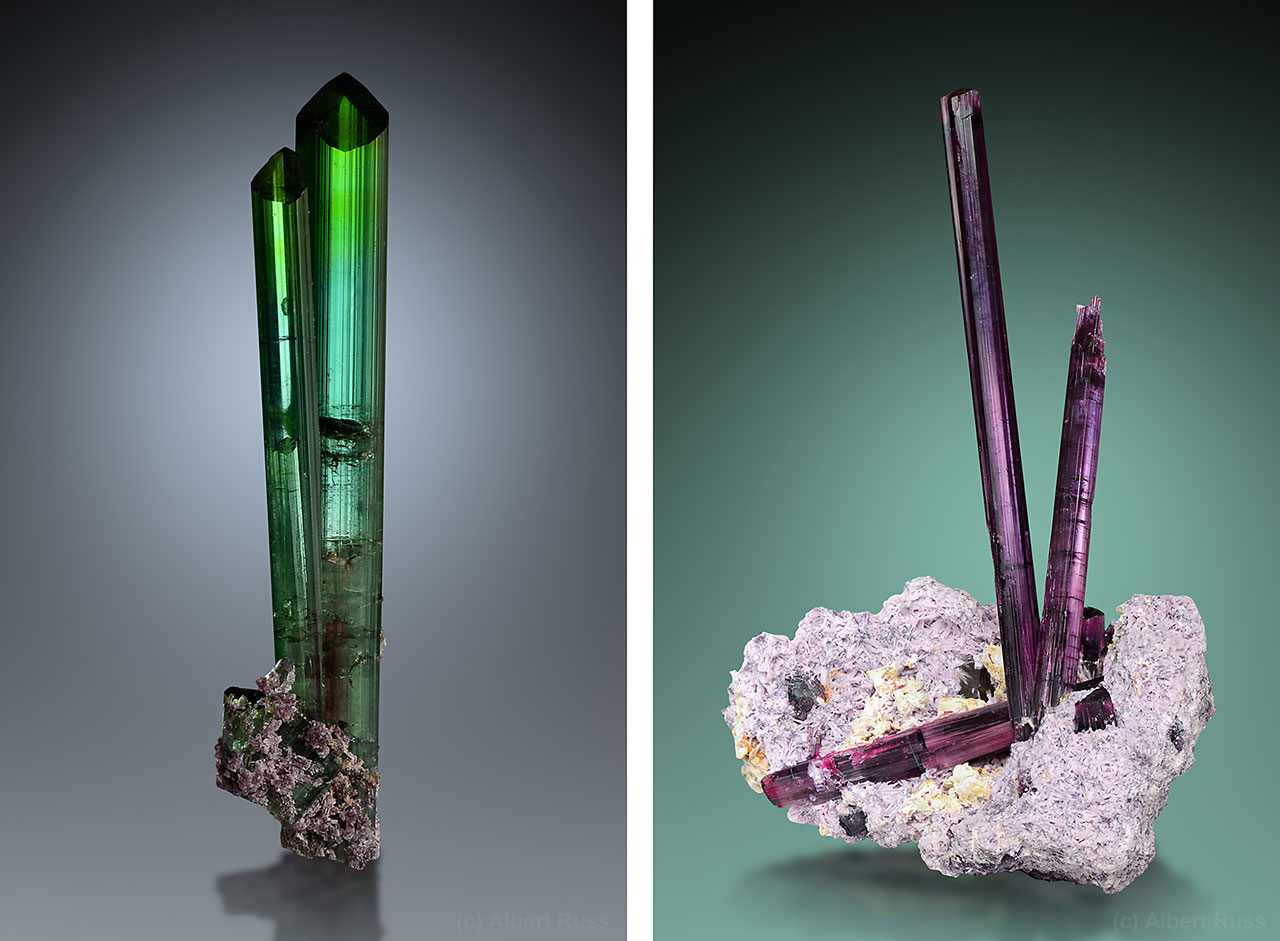
The typical real-world tourmaline is often a result of several partial substitutions at the same time. It usually contains both F- and (OH)- in W position, sometimes even O2-. The X position is mostly occupied by Na+ or Ca2+, but basically always contains some vacations. Y position is very often mix of Fe2+ and Mg2+ for common schorl-dravite tourmalines, but contains some Mn2+, Al3+, Li+ and many other ions in LCT pegmatites. Rare tourmalines contain Cr3+ and V3+ instead of Al3+ or Fe3+ in both Y and Z positions. There are often present some minor ions like K+, Zn2+, Ti4+, Pb2+ or even Sn4+.
Tourmaline Treatments
Despite the color variety of tourmalines, many specimens are simply too pale or too dark. The most targeted chromophores are Fe3+ (dark green or blue) and Mn3+ (brown), which can be reduced by careful heat treatment.
Common dark blue or dark green tourmalines (Fe2+/Fe3+ rich tourmalines) or dark red (Mn3+ rich tourmalines) are heat treated to obtain lighter color. Also, the famous paraíba tourmalines can be heated (remove pink hues caused by Mn3+), resulting in more saturated neon colors. Bright yellow tourmalines from Zambia are often heat treated, to remove brown hue caused by Mn3+.
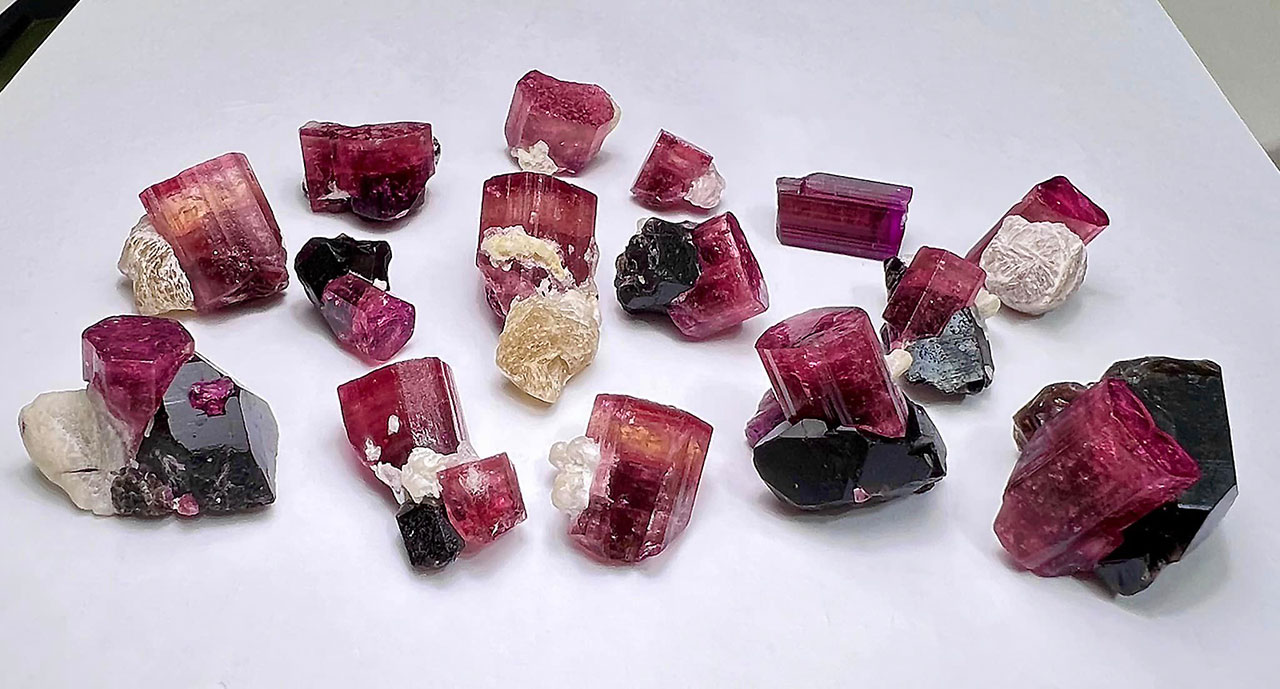
Gamma irradiation is used to boost saturation of pale crystals, turning them vivid pink to red. This color change is caused by oxidation of Mn2+ to Mn3+. Such treatment might be obvious on some specimens from Afghanistan associated with quartz, because the quartz is affected too and turns to very dark smoky or even black color.
However, the attempts to produce synthetic tourmaline are fruitless. Some experiments were partially successful, but producing gem quality material in sufficient size is a very difficult problem.
TOURMALINE MINERALS
Schorl
The common black tourmaline is often labeled as schorl, which covers also the fluor-schorl and oxy-schorl. Schorl was the first officially described tourmaline, probably known about 1400 AD or even sooner, and firstly mentioned in written resources by Ulrich Rülein von Calw in 1505.
The name is derived from its occurrence in tin mines (greisen deposit) near Zchorlau, Saxony Ore Mountains, Germany. The name had various forms, until it settled as German Schörl in 18th century and English Schorl in 19th century.
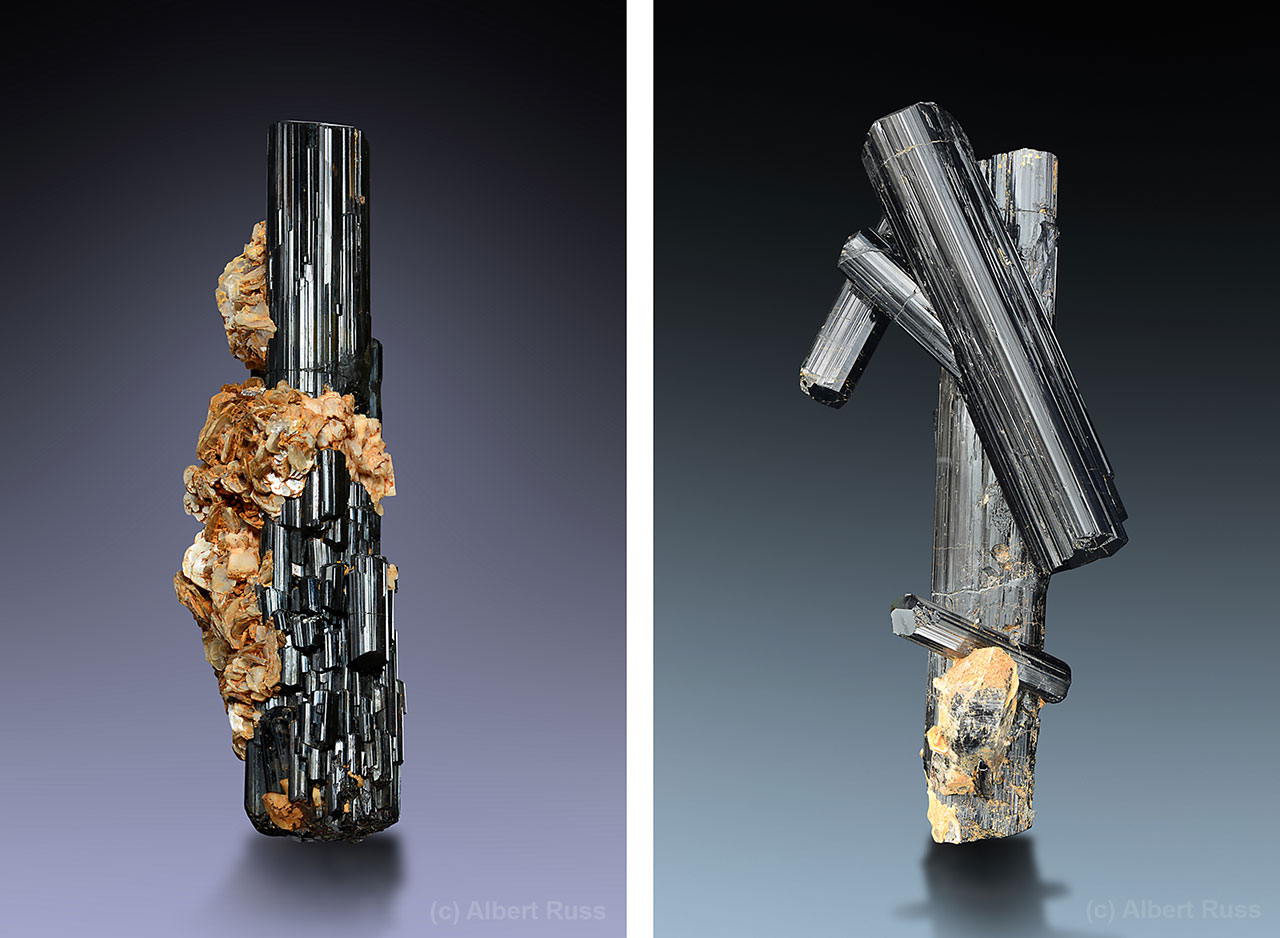
Schorl (and its fluoro-/oxy- forms) is the most common tourmaline, some estimations say up to 95% of all tourmalines. It often forms in pegmatites, greisens, some granites, hornfels, gneisses, mica schists and less often in other types of rocks.
The vastly prevailing form is the schorl, with fluor-schorl being common in highly fractionated rocks like greisens or pegmatites. The identification of oxy-schorl requires precise analytical methods and thus its often mis-identified as schorl/fluor-schorl.
Schorl was popular as mourning jewelry during Victorian era, it is still infrequently used in jewelry today.
Dravite
Dravite is the Mg-rich tourmaline, occurring mostly in metamorphic rocks like marbles and gneisses. However, it also occurs in some pegmatites, usually on the contact with Mg-rich rocks. Dravite was first described in 1884 by Gustav Tschermak from Dobrova pri Dravogradu, Slovenia. The name is derived from the river Drava. Beware that quite uncommon fluor-dravite and very rare oxy-dravite do exist.
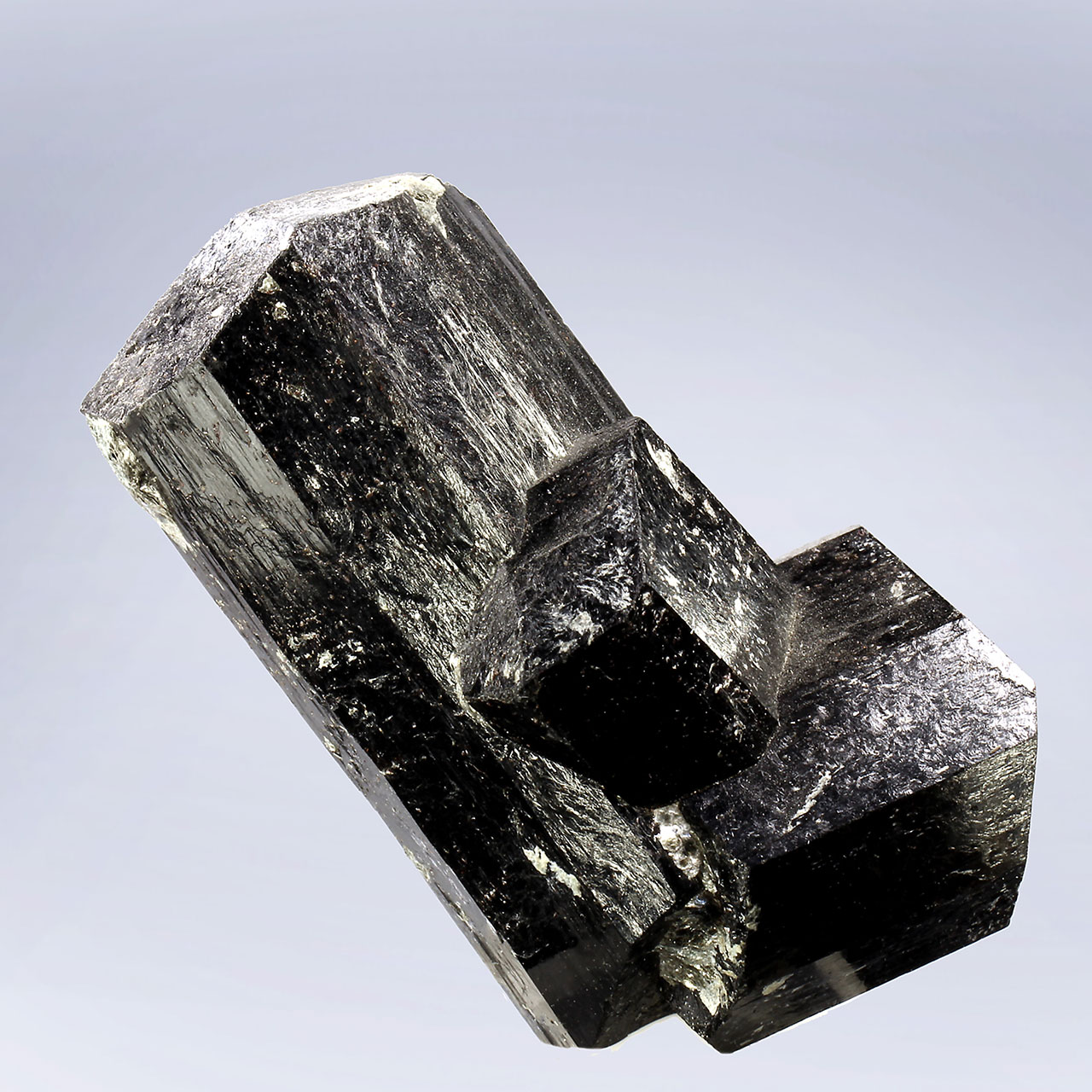
Dravite makes complete solid solution with schorl and elbaite and probably also with exotic Cr and V tourmalines. The elevated content of Cr in dravite can cause Usamara effect, which is a color change from deep green to dark red, somehow like alexandrite effect. Usamara effect is even stronger in the exotic Cr-tourmalines like chromium-dravite or oxy-chromium-dravite.
Dravite is often labeled as brown tourmaline, but it can be also brown-black, red-brown, dark red, green, or even orange and yellow.
Elbaite and fluor-elbaite
Probably the most widespread color tourmalines are elbaite (and fluor-elbaite), which occur in most LCT pegmatites. They very often occur together and cannot be distinguished without chemical or structural analysis. Elbaite was first described in 1913 by Russian-Ukrainian scientist Vladimir Vernadsky from pegmatites near Fonte del Prete, Elba Island, Italy.
Unfortunately, most of the rare lithium tourmalines looks exactly the same as the elbaite/fluor-elbaite. There is basically no way for the average collector to distinguish some of these rare minerals and they were not properly analyzed on many localities worldwide.
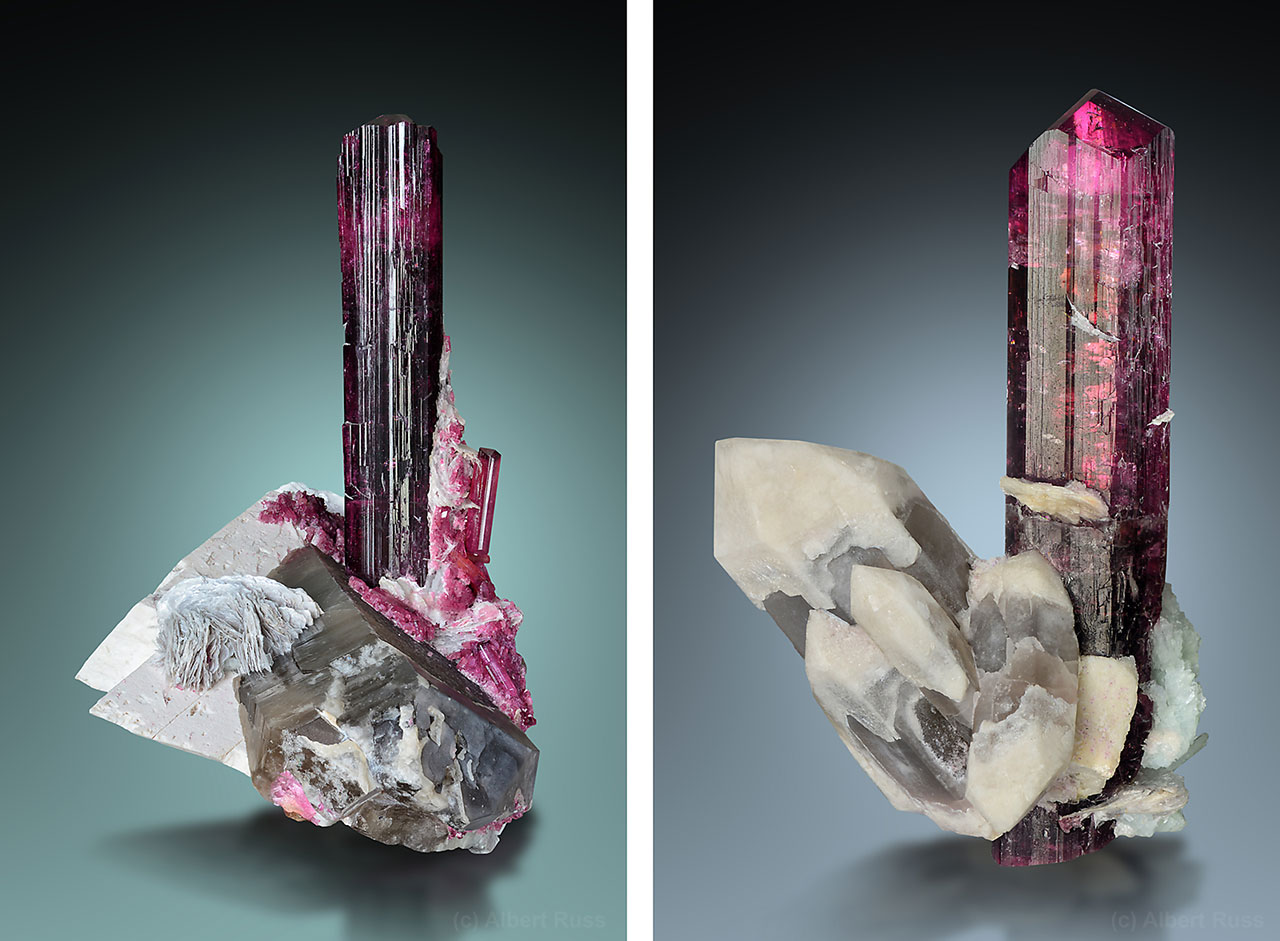
The colorful elbaites are super popular among mineral collectors and demand extremely high prices for nice specimens. Some exceptional pocket crystals of elbaite reach over 1 m in size. Elbaite occurrs in wide range of shapes, from thin elongates crystals to very thick short crystals. The terminations can be simple flat or trigonal with 3 faces, but it can also form very complex terminations.
Crystals might have uniform color, but multicolor specimens are very common. The color zones are highly variable, from core of the crystal to the rims, from bottom to the top, or it might develop very complex color patterns and growth zones. These include popular red-green watermelon tourmalines or Moor's head/Mohrenkopf tourmalines.
Liddicoatite
The liddicoatite holotype was F-dominant on W-site, but it was described as OH-dominant in original paper (Dunn et al. in 1977). It was later redefined as fluor-liddicoatite (Henry et al. 2011). The fluor-liddicoatite is vastly prevailing in nature, with OH dominant liddicoatite still not being IMA approved. However, specimens of liddiocoatite have been documented several times already. This tourmaline was named after gemmologist Richard T. Liddicoat.
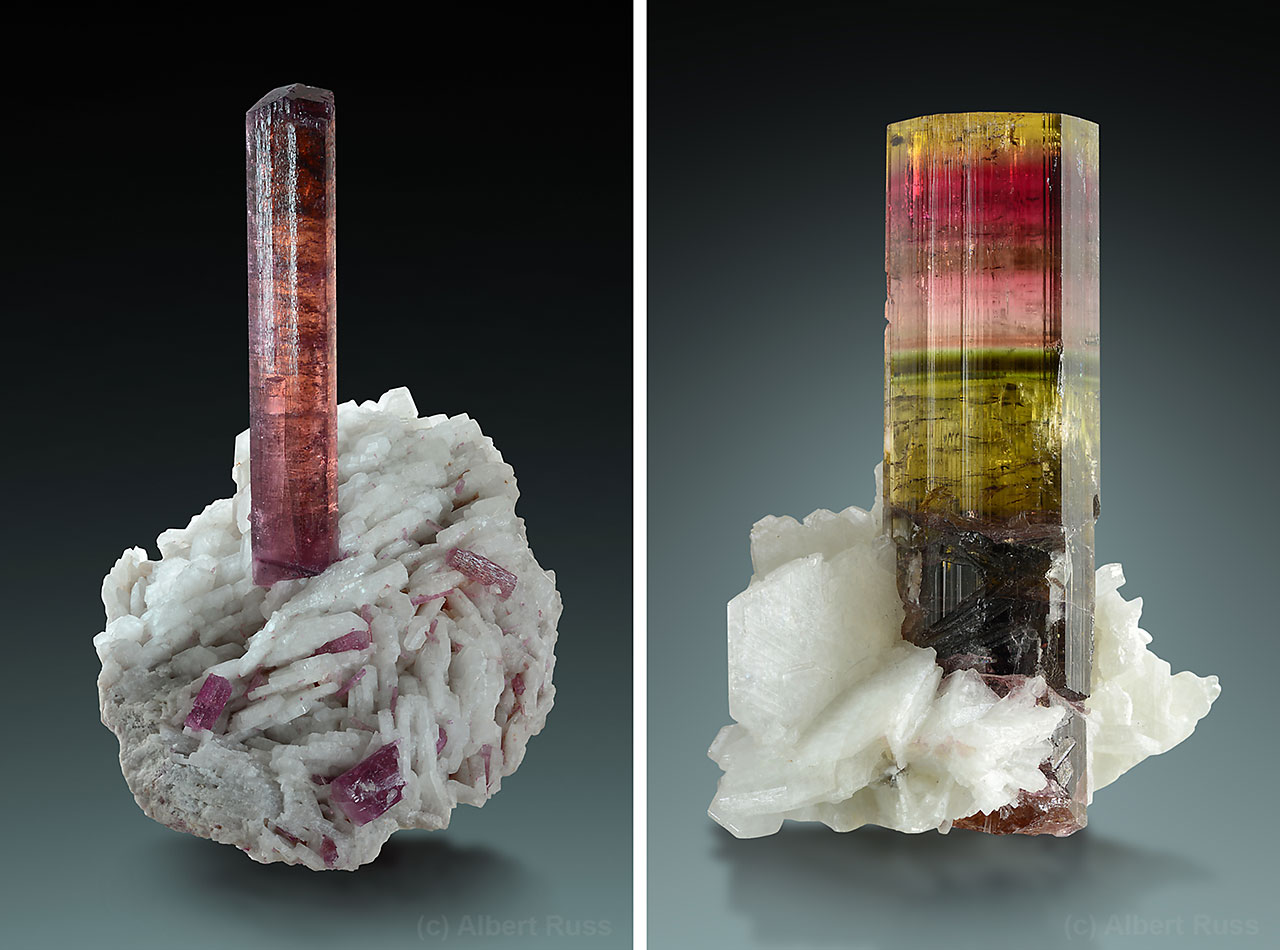
Liddicoatite belongs to very tricky tourmalines with various colors: usually pink or yellow/pale brown, but also red, green, or blue. To make it even more complicated, it forms solid solution with fluor-elbaite, which also produces highly variable colors and has similar X-ray diffraction pattern. Of course, both minerals occur together in LCT pegmatites.
Liddicoatite is common in contaminated LCT pegmatites, for example when the pegmatite is emplaced in marble or calc-silica rocks.
Uvite and fluor-uvite
The original material from Uva province, Sri Lanka, was redefined as uvite (Henry et al. 2011). But later analytical work raised some doubts and the uvite was discredited in 2018 and later in 2020 approved again from a new type locality on Elba Island, Italy. Modern analytical research also revealed that most uvite specimens are in fact fluor-uvite, while uvite is quite uncommon. Uvite forms a solid solution with Fe-dominant feruvite.
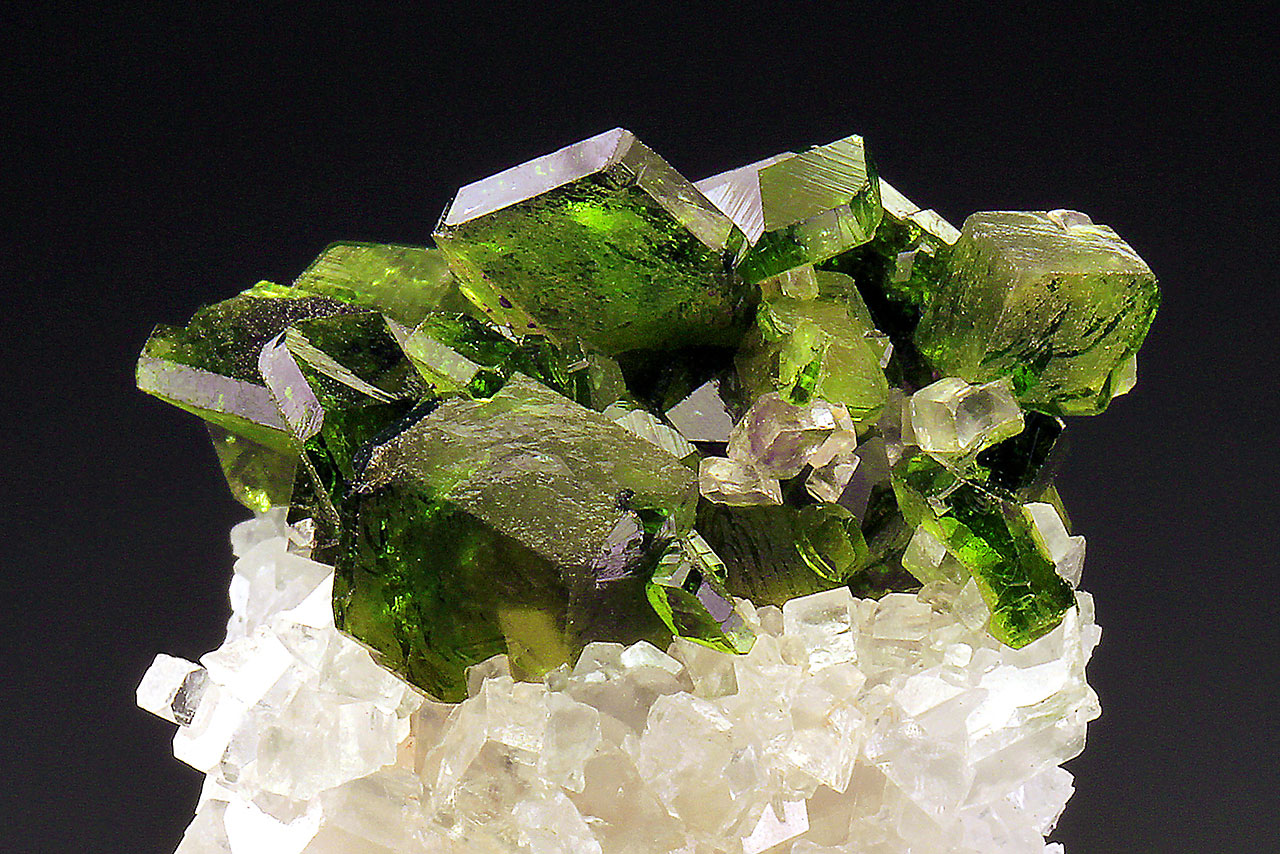
Uvite or fluor-uvite occur in Ca- and Mg-rich rocks, which are usually some calc-silicate rocks, silicate rich marbles, meta-evaporites or some exotic metasomatic rocks. Feruvite occurs in metasomatic rocks like Ce-Fe skarns or some heavily contaminated pegmatites.
Uvite and fluor-uvite have various colors, usually brown, red-brown, orange, red, pale to very dark green or even black. The feruvite is always black because of the high Fe2+ content. This produces problems with distinguishing uvite and fluor-uvite from much more common dravite and feruvite from common schorl.
Foitite
Foitite is basically vacant Al-rich version of schorl, which might be quite common in some pegmatites and metamorphic rocks. It is very dark blue or purple or even appears black, so it is basically impossible to distinguish from schorl. And complex analytical work is rarely done on common black tourmalines.
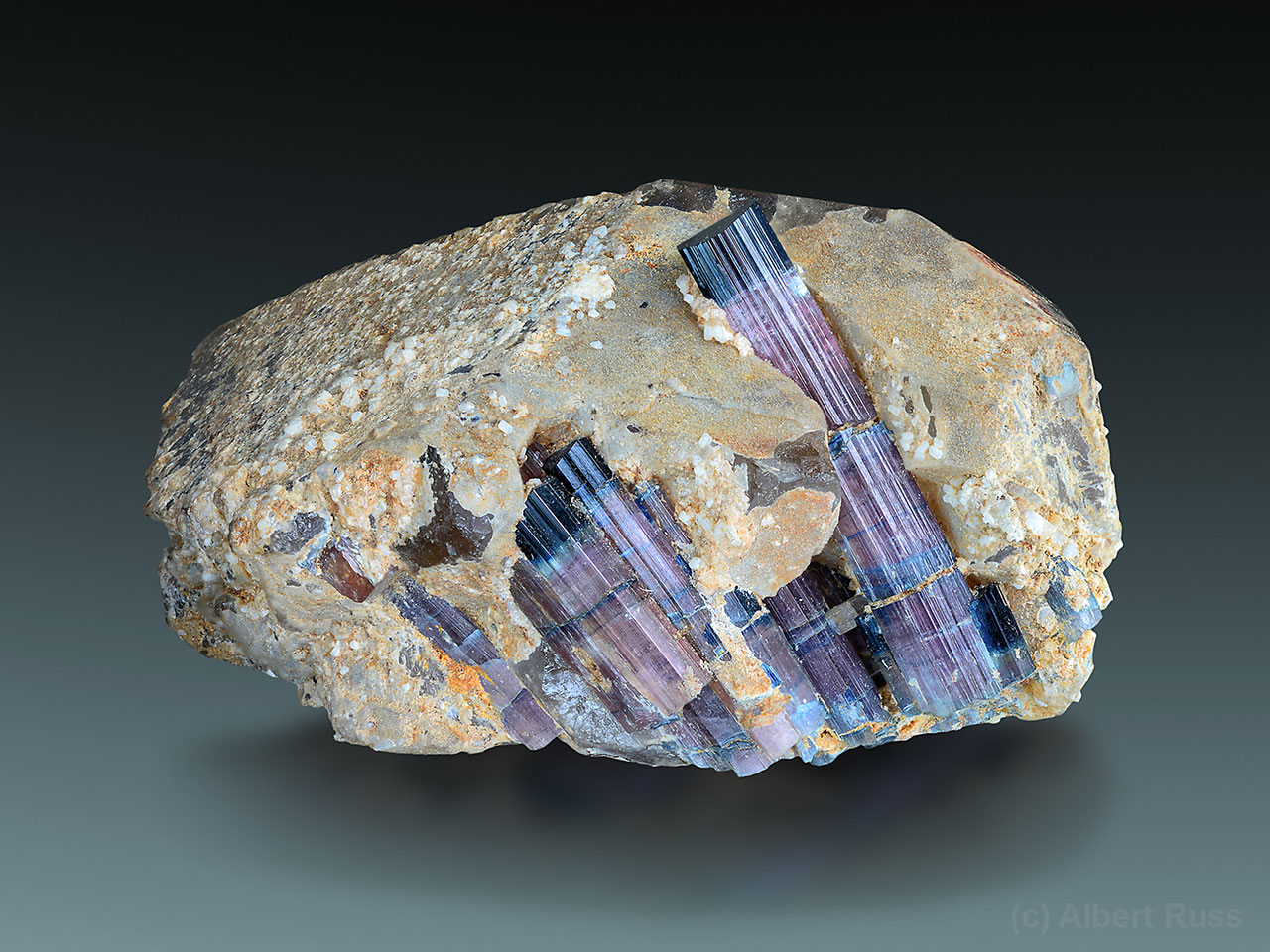
Foitite can be present both in the outer units of pegmatite, as well as late alteration product in the form of rims, caps (the Moor's head tourmalines) or fibrous aggregates.
Olenite
The most Al-rich tourmaline is named olenite. It occurs in extremely Al-enriched pegmatites, but also in some HP/UHP metamorphic rocks. Olenite makes solid solution with schorl, elbaite, and extremely rare alumino-oxy-rossmanite. Olenite is not very common, but its colors match common elbaite/fluor-elbaite colors. Thus, it can be easily overlooked without proper analytical work.
Lithium-rich Tourmalines
There are numerous Li-rich tourmalines besides the most common elbaite/fluor-elbaite and fluor-liddicoatite. The IMA valid endmembers include Al-Li rich darrellhenryite and vacant Al-Li rich rossmanite. However, some other tourmalines - formally without Li - like tsilaisite, fluor-tsilaisite and olenite often contain significant content of Li too. Of course, members of schorl-elbaite solid solution basically range from Li-rich schorl to Fe-rich elbaite.
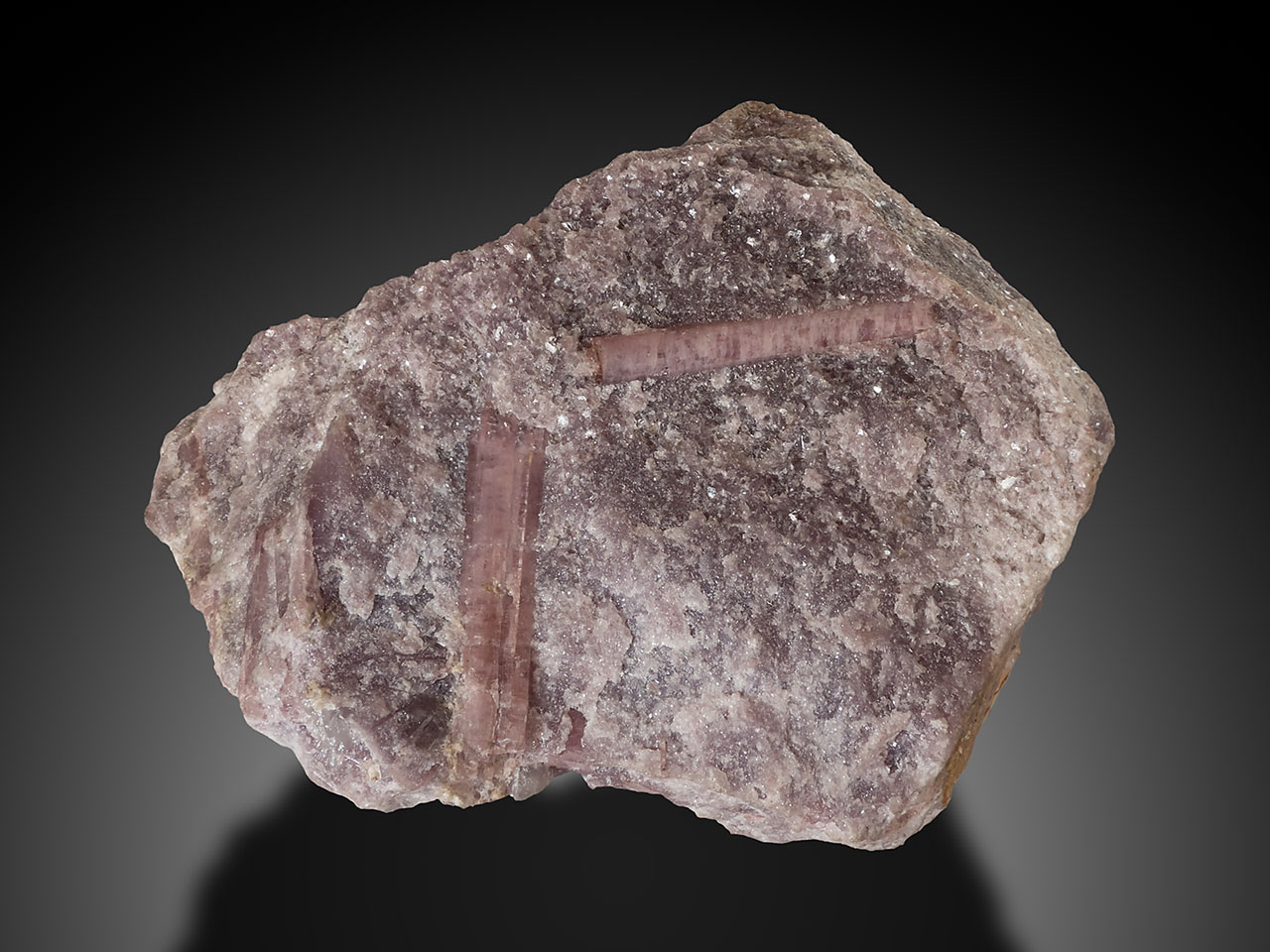
Unfortunately, most of these Li-rich tourmalines share the common pink color, and even worse, they occur together in internal units of LCT pegmatites. They are probably much more abundant than anticipated, but their identification requires detailed and systematic sampling of the pegmatite. This is rarely done, because its expensive and time-consuming process.
Chromium- and Vanadium-rich Tourmalines
Very rare Cr and V rich tourmalines are often limited to exotic metamorphic rocks, usually originating from ultramafic rocks or heavily contaminated. Geological environments rich in Cr/V and high Al and B content at the same time are very uncommon.
All of these Cr/V exotic tourmalines except chromium-dravite were first discovered from Sludyanka at lake Baikal, Russia. Some were later reported from other localities too. Most or all of Y and Z positions of these tourmalines is occupied by Cr3+, V3+ or both, the other common element being Mg2+.
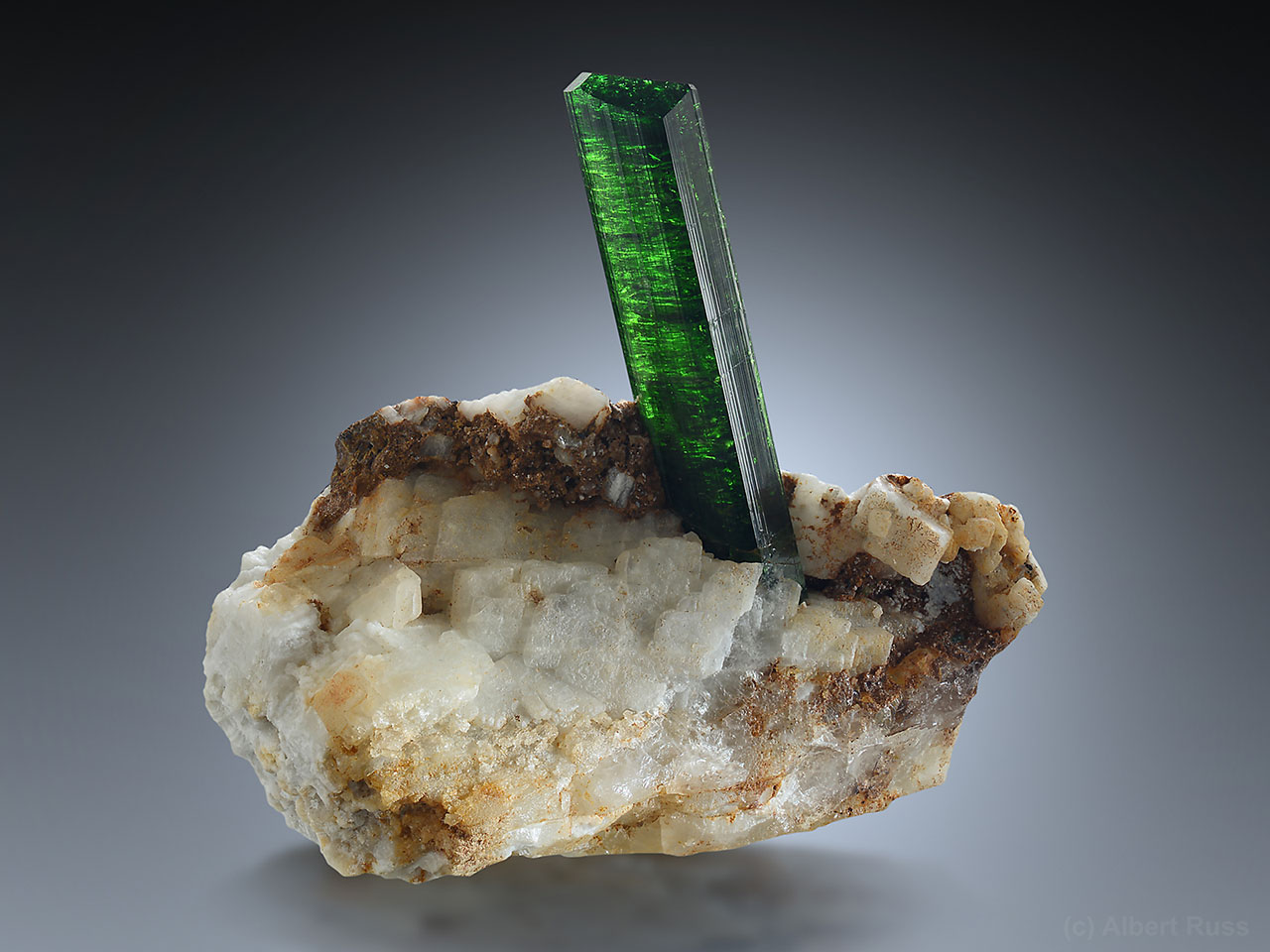
Unfortunately, naming of these tourmalines is quite confusing. Chromium-dravite and oxy-chromium-dravite do not differ only on W position but have unpredictable difference also on Y and Z positions (Mg disorder). And oxy-vanadium-dravite, vanadio-oxy-dravite and vanadio-oxy-chromium-dravite are even more confusing. This is unfortunately result of inconsistency in naming conventions.
TOURMALINE VARIETIES
Paraíba Tourmaline
Unlike the other tourmalines, the neon blue variety paraíba or paraiba tourmaline, is not an IMA approved mineral. From the scientific perspective, its elbaite or fluor-elbaite with high content of Cu (up to several wt.% of CuO). Only few rough pieces were analyzed as liddicoatite. These copper-rich tourmalines (or cuprian-tourmalines) also have significant content of Pb2+ and possibly also Pb4+ and Bi3+. The color might degrade due to the increased content of Mn3+, which turns it into the blue-pink hues.

The term was originally used for a Cu-rich elbaites from Paraíba state in Brazil, which were discovered in 1989. However, almost identical tourmalines were discovered in 2000 in Nigeria and later also in Mozambique. The true origin might be revealed by quantitative chemical analysis of the trace elements, usually by LA-ICP-MS. Unfortunately, even the trace element content has significant overlap.
Subsequent discussions lead to a decision that paraíba tourmaline will be a valid trade name for all Cu-rich tourmalines of the green/blue color, regardless of their origin. Keep in mind that most of the paraíba tourmalines lack the highly popular neon blue and their color might gradually change to blue or green.
Watermelon tourmalines
The most common watermelon tourmalines are pink inside with green rim. This color zonation is often visible only when the crystal is sliced perpendicular to its long axis. However, there are more complex growths patterns, including several concentric layers and/or geometric shapes. The colorful elbaite or liddicoatite crystals are most popular, but similar patterns can be found even within common schorl, when sliced to very thin slabs.
Moor's head (Mohrenkopf) tourmalines
The colorful tourmalines with black cap at the termination are called Moor's head. First such specimens were observed at the elbaite type locality on Elba Island, where this growth pattern is quite common. However, they occur in numerous LCT-pegmatites worldwide. The most common terminations are black, but also pink, blue, or purple varieties exist.
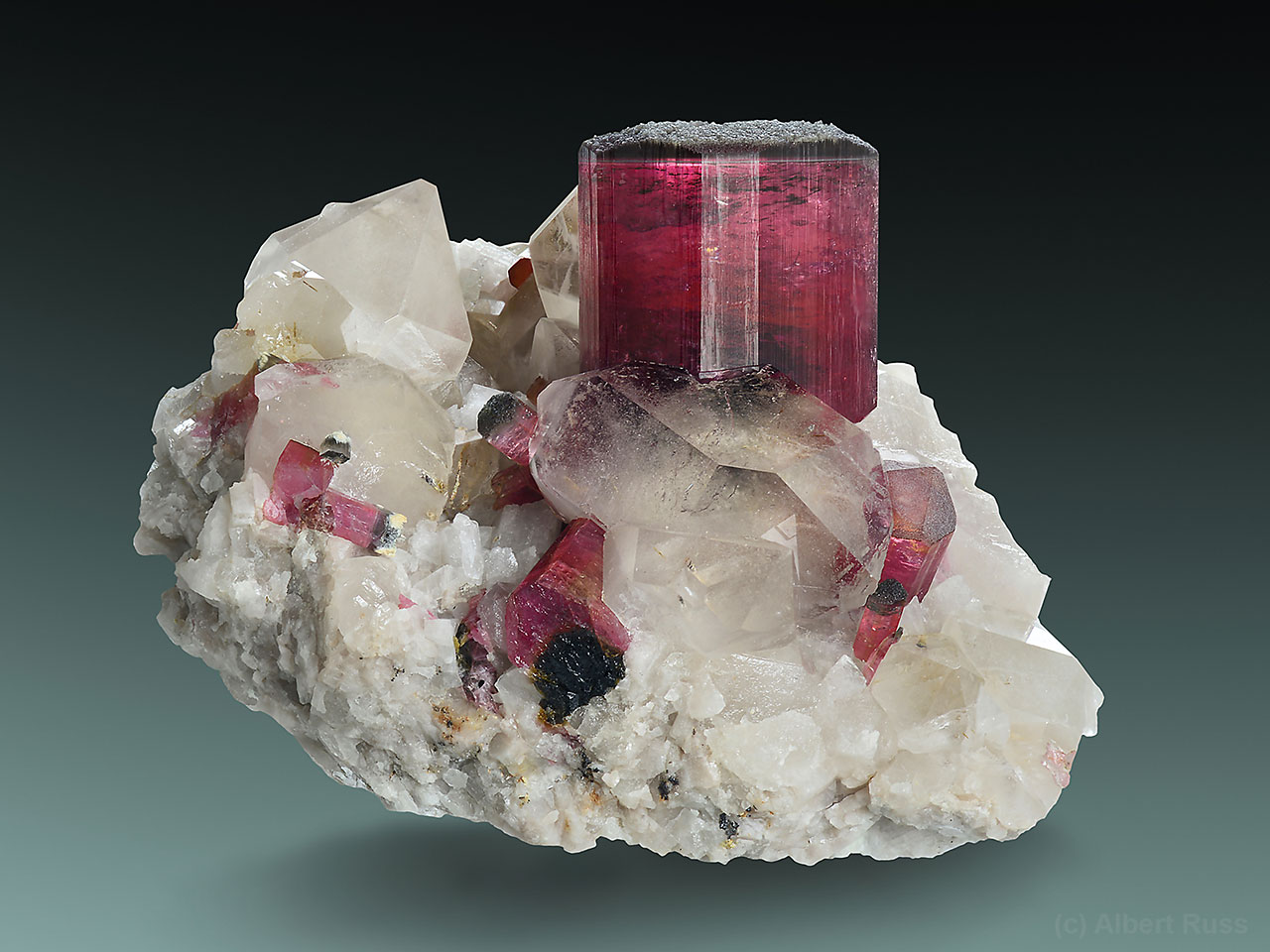
The crystal grows from the bottom to the top, when the fluid composition inside the pocket changes. This abrupt color change is usually caused by the Fe2+. When the Fe2+ content gets higher, the dark or black iron-rich tourmaline forms the termination. On the other hand, when Fe2+ is depleted, the Mn2+ becomes major chromophore and the termination color is pink.
REFERENCES
- Abduriyim A., Kitawaki H., Furuya M., Schwarz D. (2006): Paraiba"-type copper-bearing tourmaline from Brazil, Nigeria, and Mozambique: Chemical fingerprinting by LA-ICP-MS. Gems and Gemology, 42 (1), 4.
- Cornejo C., Bartorelli A., Wilson. W. E. (2019): The golconda District, Minas Gerais, Brazil. The Mineralogical Record: 50 (5), 519-627.
- Fisher J. (2002): Gem and Rare-Element Pegmatites of Southern California. The Mineralogical Record: 33 (5), 363-407.
- Henry, D. J., Novák, M., Hawthorne, F. C., Ertl, A., Dutrow, B. L., Uher, P., Pezzotta, F. (2011): Nomenclature of the tourmaline-supergroup minerals. American Mineralogist, 96 (5-6), 895-913.
- Lees B. K., Kynicky Jindrich, Kynicky Jan, Song W., Kotlanova M., Wagner G., Persson P. (2019): The Malkhan Pegmatite District, Krasny Chikoy, Transbaikalia, Eastern Siberian Region, Russia. The Mineralogical Record: 50 (3), 245-324.
- Lyckberg P. (2017): Gem Pegmatites of Northeastern Afghanistan. The Mineralogical Record: 50 (5), 611-675.
- Pezzota F. (2021): A history of tourmaline from the Island of Elba. The Mineralogical Record: 52 (6), 669-720.
- Simmons W. B., Staebler G. (Eds.) (2019): Rubellite – Tourmaline Rouge. Lithographie Ltd., Arvada, Colorado, USA.
- Swoboda E., Larson W. F. (2002): History of the Tourmaline Queen Mine, San Diego County, California. The Mineralogical Record: 33 (5), 409-425.





Comments